































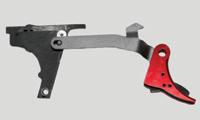


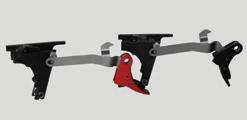
Introducing the ELF Glock Trigger, for Glock Gens 1-4. This advanced trigger is engineered for precision, featuring a short creep and a glass-like break that guarantees swift and accurate firing. With an adjustable pull weight ranging from 1 1/2 to 3 1/2lb, this trigger caters to individual preferences for a personalized shooting experience. The aluminum trigger shoe, available in sleek black or vibrant red, brings style and also ensures durability. Crafted from A2 steel, the ELF Glock Trigger delivers both longevity and reliability, utilizing the Glock’s stock firing spring and stock safety spring for full ignition. The Glock Slide will need to be milled which ELF offers as a service.


The ELF APEX Trigger has been built for performance. Pull weight is so easy to adjust it can be done in seconds without removing the trigger from your lower receiver. A second-to-none AR-Platform drop-in trigger system that is strong and light, made of wire EDM machined, hardened A2 tool steel and lightweight aircraft-grade aluminum. Available with a curved or straight shoe along in black or red. It can also be purchased in our Pro Lock Threaded Mounting System.
The amazingly short take-up, glass-rod crisp break, no skip technology and our new adjustable sear lets you customize the over-travel can be compared to the finest custom 1911 triggers. If you are looking for the finest adjustable trigger for your AR platform, this is the trigger system for you.
The ELF-SE Drop-In Trigger maintains the Elftmann reputation for quality, craftsmanship and customer service in an affordable package. Extremely short takeup, clean crisp break and very short, positive reset. It has a brand new look and features such as, an adjustable pull weight being one of them! Available in our Pro Lock Threaded Mounting System.
Fits any and all AR platforms (large pin Colt available) with features including: Drop-safe, adjustable from 2 3/4 to 4lbs without removing from lower, Patented Double-Double torsion hammer spring, short pull and reset allows for rapid follow up shots, lightweight aircraft-grade aluminum and hardened steel construction, design of disconnector allows full 1/4” width eliminating possibility of wear and double-firing, adjustable aluminum trigger shoe (available in straight or curved, red or black)








The FG-15 is just a grip when not in use, when the handle is deployed it is a trigger crank, allowing you to fire one shot per 120 degrees you crank the handle.
The FG-15 has been tested on a 20 year old Bushmaster, new Aero Precision, Daniel Defenses, LWRC, Ruger, Bravo Co, to name a few. Aside from the twin stainless Japanese precision ball bearings, the FG-15 is an American made and seriously overbuilt piece of kit. Comprising of nitride 4140 steel machined components, hardened S7 trigger striker pin, and many more high quality components. The FG-15 was mechanically tested for over 1,000,000 shots fired. At that point, the components showed only a light surface finish wear.
In the prone and with your weapon on a bipod, it allows the user to consistently put shots on target without trigger fatigue. Any AR-15 type firearm that has a 1/4-28 thread pitch for the grip screw will accept the FG-15 grip. Which is 99% of AR-15 lower receivers.


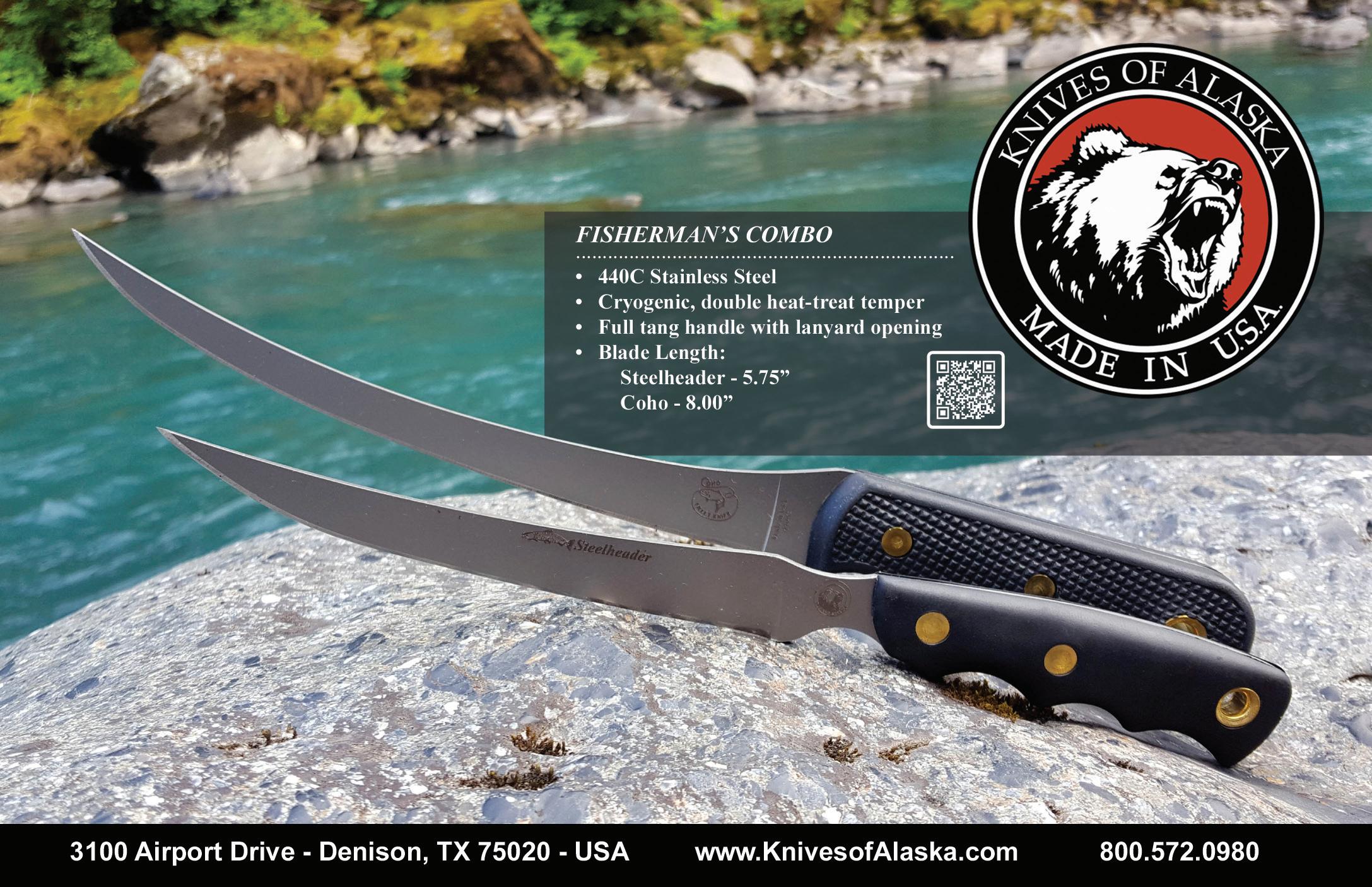

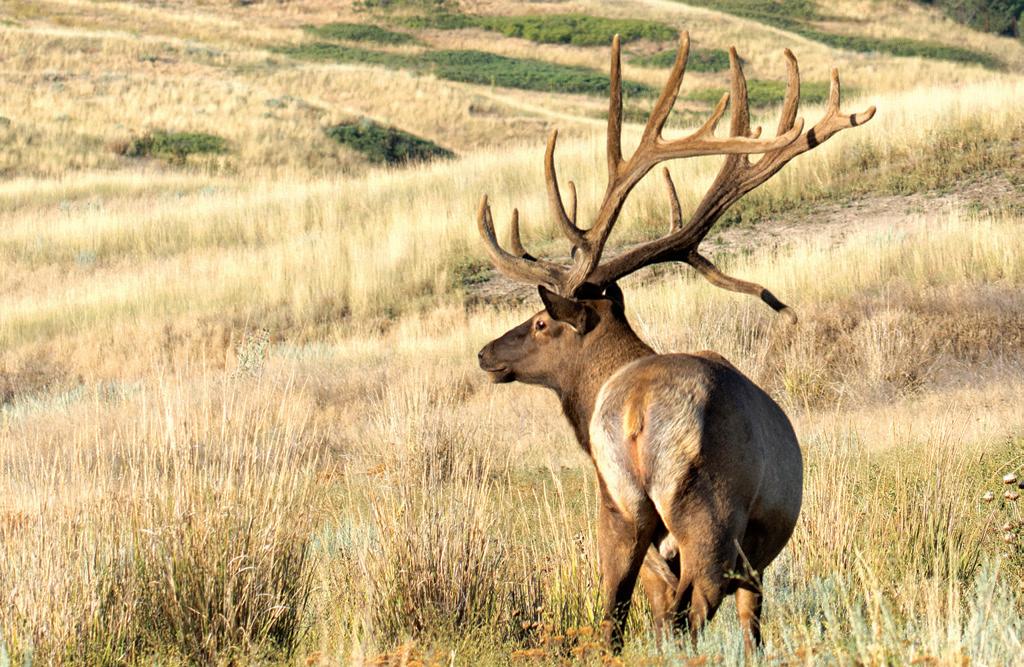









PUBLISHER
James R. Baker
GENERAL MANAGER
John Rusnak
EXECUTIVE EDITOR
Andy Walgamott
EDITOR
Chris Cocoles
WRITERS
Scott Haugen, Tiffany Haugen
SALES MANAGER
Paul Yarnold
ACCOUNT EXECUTIVES
Tawna Lucero, Tom St. Clair
DESIGNERS
Gabrielle Pangilinan, Lesley-Anne Slisko-Cooper
PRODUCTION ASSISTANT
Emily Baker
WEB DEVELOPMENT/INBOUND MARKETING
Jon Hines
ADMINISTRATIVE ASSISTANT
Katie Aumann
INFORMATION SERVICES MANAGER
Lois Sanborn
ADVERTISING INQUIRIES media@media-inc.com
MEDIA INDEX PUBLISHING GROUP 941 Powell Ave SW, Suite 120 Renton, WA 98057 (206) 382-9220 • Fax (206) 382-9437 media@media-inc.com • www.media-inc.com
ON THE COVER
Founded in 1996 in Vermont by a fly fisher and a surgeon, nonprofit organization
Casting for Recovery now annually offers 60 free retreats across the country for 800 women who have breast cancer. This year’s Alaska retreat is set for September 6-8 at River Raven Sanctuary Lodge in Soldotna. (MISSY SHOFNER SPROUSE/CASTING FOR RECOVERY)
CORRESPONDENCE
X @AKSportJourn Facebook.com/alaskasportingjournal Email ccocoles@media-inc.com



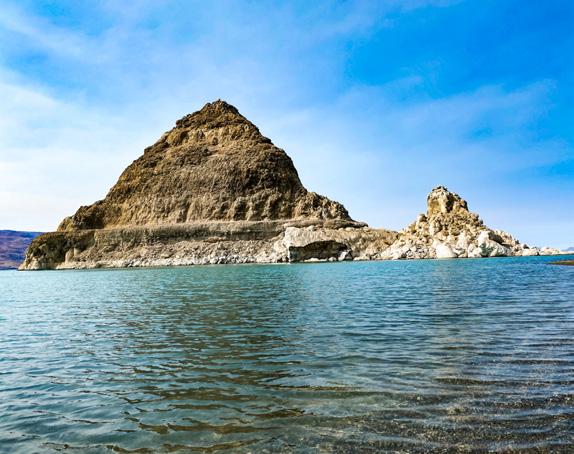


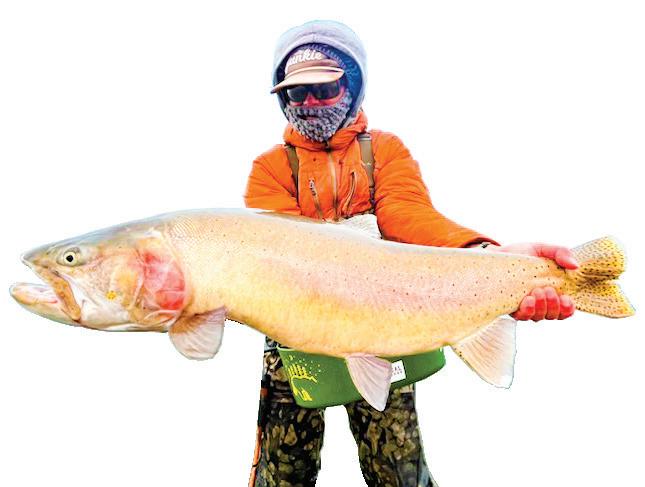
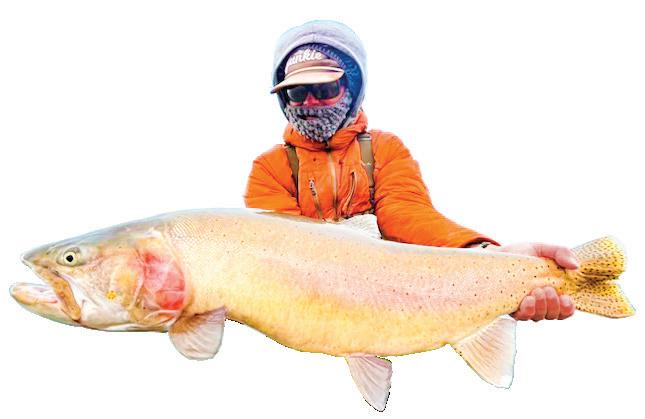

A strong support network makes living with cancer a little easier. And that even stretches to the most unlikely places, such as the banks of an Alaskan river. Jen Lofgren shares how Casting for Recovery, a nationwide nonprofit, offers free fly fishing retreats for women diagnosed with breast cancer and has impacted both participants and volunteers.
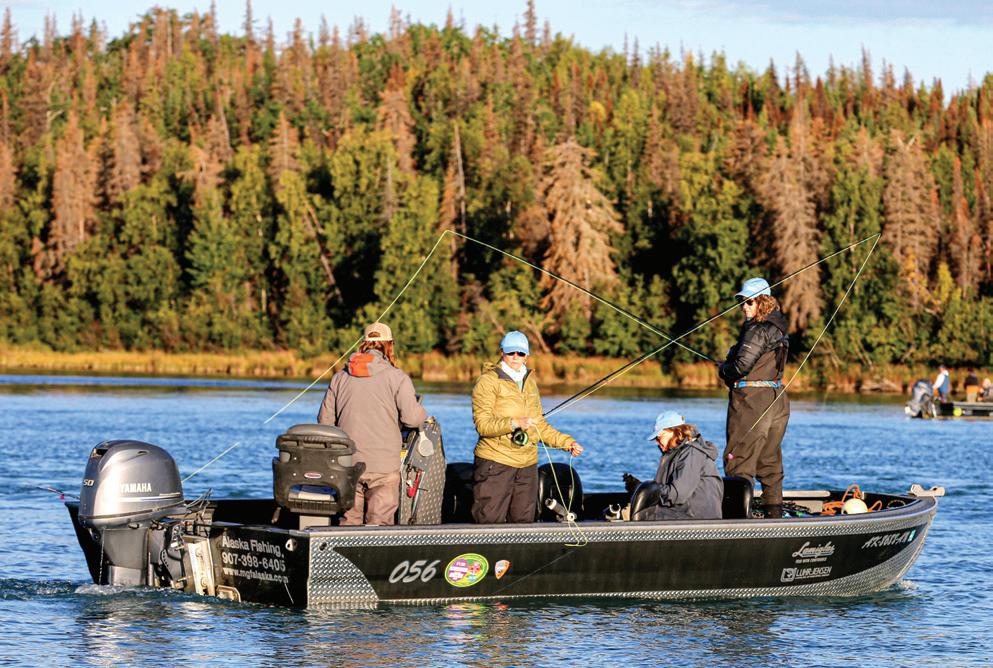
38 SUMMER OF HALIBUT IN HOMER
For more than 30 years, Homer held a halibut derby over a single weekend, then last year switched to the entire month of June. The successful expansion of the event prompted the community to stretch the new-look Homer Halibut Derby even further, and this year you’ll be able to enter from May 13 all the way through Labor Day weekend for weekly prizes. Brad Anderson of the Homer Chamber of Commerce details what to expect this year.
42 END OF THE ROAD FOR AMBLER ROUTE?
Editor’s Note: Memories of Mom’s
Alaska
Outdoor Calendar 58 From Field to Fire: Best of bear hunting gear and a savory trout recipe
State development officials have proposed building a private 211-mile road that would connect the Ambler Mining District with the Dalton Highway. Opponents say the road would threaten caribou herds around the Brooks Range and salmon runs in the Kobuk River. The Biden Administration agreed and in mid-April announced it wouldn’t allow the road to be constructed. We have reactions from both sides of the debate.
51 SPRING BEAR TALES
May is prime time to get after spring bruins throughout Alaska, and our longtime correspondent Scott Haugen shares two of his favorite experiences pursuing black and grizzly bears in two remote Last Frontier outposts. Find out if Scott was able to fill his tags in compelling adventure stories from the wilderness!






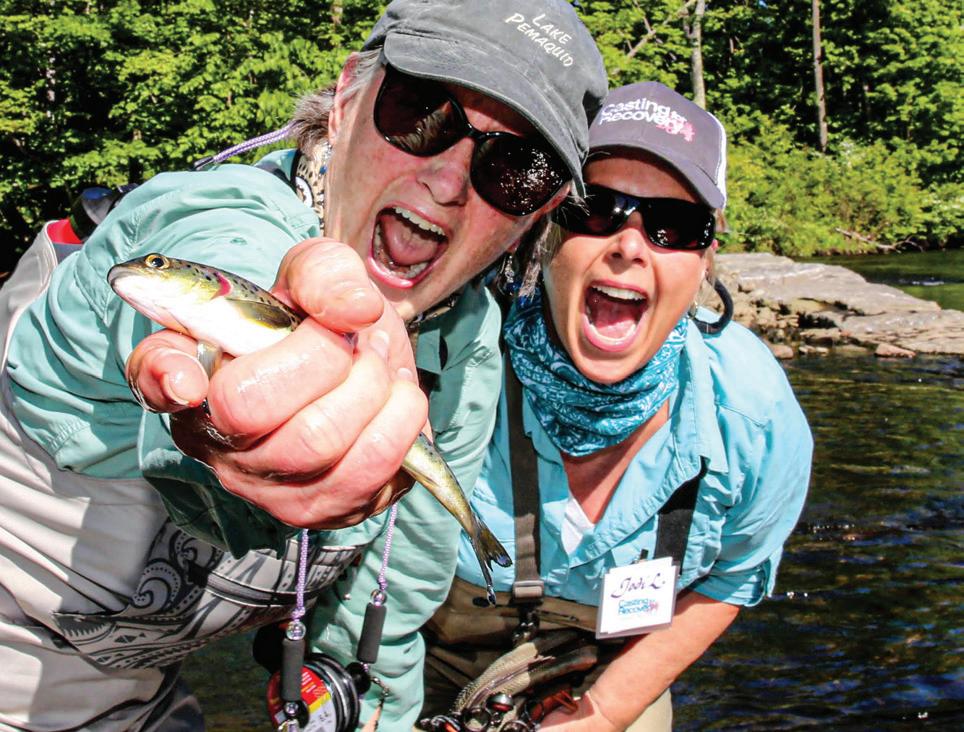
I’ve been working on and off on this month’s feature story profiling the breast cancer patient fly fishing organization Casting for Recovery, and all I keep thinking about is making sure I get it right. Or at least hit all the right notes. I’ve certainly stressed about it enough leading up to our May issue.
Like so many of us, breast cancer has affected my family. My mom was diagnosed in the early 2000s, went into remission, but it returned, and after a short battle she passed away from the disease in September 2007.
I had a dear friend I worked with in Los Angeles whose mom was also diagnosed with the same disease shortly after my mother (her mom died a couple years after mine). It was important for me to walk in multiple fundraisers to support breast cancer patients, and now years later I felt honored to have an extended chat with Casting for Recovery’s regional program manager Jen Lofgren – she coordinates fly fishing retreats in
Alaska and other Western states – and corresponding with executive director Susan Gaetz and others for the story.
It was a hard story for me to write; lots of memories of my mom, my friend who lost touch with me, the stories Lofgren told me about interacting with these remarkable women. They were going through pure hell but found some peace with a fly rod on a quiet river in Alaska or other waters throughout the country. I wanted to know how they held it together while in the fight of their lives.
Lofgren told me about how the same women who came in without any background in fishing were the same ones who wanted to kiss the trout they’d just caught. Just being there makes them badass in my book.
“I say this at every retreat: I often question whether or not I would have the courage to do it. It’s 14 women who are randomly selected. It’s not like they can pick who their roommate is going to be, or ask their pals to come along
for support. They don’t know a soul. They’re likely going to have to share a room and a bathroom,” Lofgren said. “They’re already in this vulnerable place, dealing with all kinds of sh*t. I can’t tell you how many times I have heard a woman say, ‘I started driving down the road to the venue, and then I turned around, but then I came back, and I am so glad I did.’ I get it. I think it takes tremendous courage to step into the unknown.”
My mom probably wouldn’t have done it. She was a sweet, kind person, and she had her comfort zone and this wasn’t it. But I know she would love that I wrote a story about breast cancer patients who are willing to take a pause from their battle by learning to fly fish with like-minded ladies who epitomize toughness, strength and resilience.
I only hope I did right by everyone who is involved in this great organization, because it’s an important subject to share. -Chris Cocoles

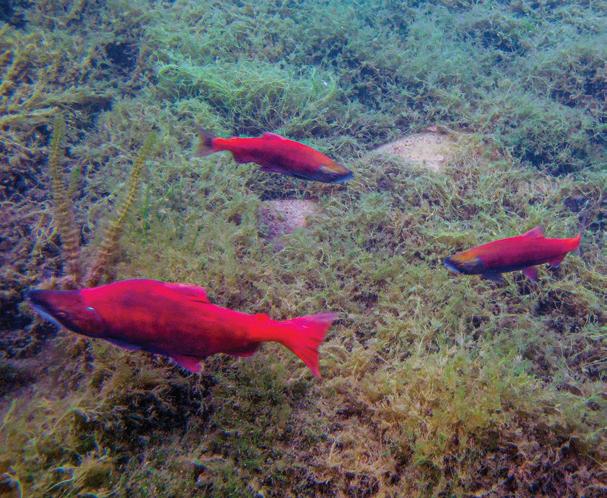
Another month, another blow to the Pebble Mine’s parent company as the project remains blocked.
That’s great news for Bristol Bay, its $2 billion salmon fishing industry and the vocal opposition that has fought for decades to prevent the gold and copper mine from ever breaking ground.
And since 2020, the setbacks have piled on top of each other for the Pebble Partnership and Northern Dynasty Minerals. The latest for the mining companies? Their appeal to the US Army Corps of Engineers to reverse its 2020 decision that rejected Pebble’s permit application was denied.
Northern Dynasty CEO Ron Thiessen claimed the Corps’ decision was an “unsupportable federal bureaucratic position” linked to the Environmental Protection Agency’s 2021 decision to cite Clean Water Act protections to essentially kill the mine regardless of the Corps’ opinion.
“The EPA veto rests upon USACE findings in its permit denial, which were rebuked by its own internal administrative review; and now USACE refuses to address the critical flaws in its own permit denial decision as ordered by its own administrative review because EPA has vetoed the project,” Thiessen added.
The mine companies’ best hope now to end their string of defeats and public relations nightmares in the last four years probably hinges on the results of this fall’s presidential election. Meanwhile, in a press release, Trout Unlimited Alaska program director Nelli Williams said the push will continue to get permanent protections for the region “(so) that we don’t have to keep fighting projects that compromise the area’s jobs and incredible fish and wildlife in the future.”
Added Tia Shoemaker, whose family operates Bristol Bay-based tour company Grizzly Skins, “Alaskans and business owners in Bristol Bay have been clear that Pebble fails to meet the required standards to ensure clean water and healthy fish habitat. We are glad to close this chapter and look forward to securing durable protective measures for the fish and wildlife we depend on throughout the region to run our businesses.”





FDR once experienced Alaska’s fishing culture in the middle of a war.

“The white zone is for loading and unloading only. There is no caribou parking in the white zone.”

Grand prize cash payout in the Valdez Halibut Derby, which starts on May 25 and runs through September 1.
THEY SAID IT
“Both
“ ”
Mount Polley and Brumadinho have smaller tailings storage facilities to Donlin, yet the administration failed to conduct a model for dam breaching aligned with these two known storage failures. The Biden Administration must conduct a thorough EIS that looks at the potential risks. Lives are on the line; we can’t afford to cut corners.”
–Sophie Swope, executive director of the Mother Kuskokwim Tribal Coalition, after a report concluded that toxic mine waste from the proposed Donlin Gold Mine in Southwest Alaska would pose “significant threats” to the Kuskokwim River watershed.
Longtime bear hunter Brian Watkins (far left) hunted a specific bear so massive and regal that it became known as King Tut among he and his friends. Finally harvesting that royalty was satisfying. (BRIAN
WATKINS)
Twelve bears were coming in to my bait station; one of them was the king himself, Tut. He was coming in the middle of the night, so I told my brother Kevin it would be a long sit. I went back to pick up dog food to restock the bait.
As I was returning to the area, I heard Kevin’s wife Samantha say, “Bear! He’s right next to you. Don’t move.”
It’s really thick where I bait, so I couldn’t see anything. The world seemed to stop spinning and got quiet. I was within 15 yards of a bear and had no clue it was there. I dropped the bag off my shoulder and grabbed my pistol.
Boom! Kevin shot. Boom! He shot again. I saw the bear through the alders and sent a couple rounds his way. As my heart raced, the bear thrashed through the woods –luckily, away from me.
The woods grew silent and we waited an hour to see how bad the bear was hit. I didn’t know whether it was Tut or not, just that it was a big bear. We crawled through bear trails and followed blood.
We crossed into another finger of the valley and heard a bear. It was breathing heavily and grunting loudly. It was within 50 yards, but we couldn’t see him. He would bluff-charge our direction and back off. The entire time we held guns facing his direction. We backed out slowly and gave him more time. There were bubbles in his lungs, so we figured he had one lung hit. We gave him two more hours and headed back in.
My brother carried a .300 Win. Mag.; I had a 10mm pistol. It felt like a peashooter, but we went anyway. When we got to where the bear was, he was nowhere to be found. My brother went into the valley bottom looking for blood, while I crested the top. When I came over the mountain, I smelled bear.
I found blood and got back on his trail. He was sitting down like you would at a dinner table. I fired three rounds and imagined him charging me. I turned and ran down the mountain, crashing and rolling to get away as fast as I could. Kevin screamed for me. He could only think that an all-out battle between the bear and I was taking place.
I tumbled down the mountain to my brother for backup, and as I calmed down I realized the bear was nowhere near me. My heart raced and I felt panic, but all was well. We went back up and the bear was laying on his side. Kevin had to finish him off. We realized we had finally outsmarted the king himself. -Brian Watkins

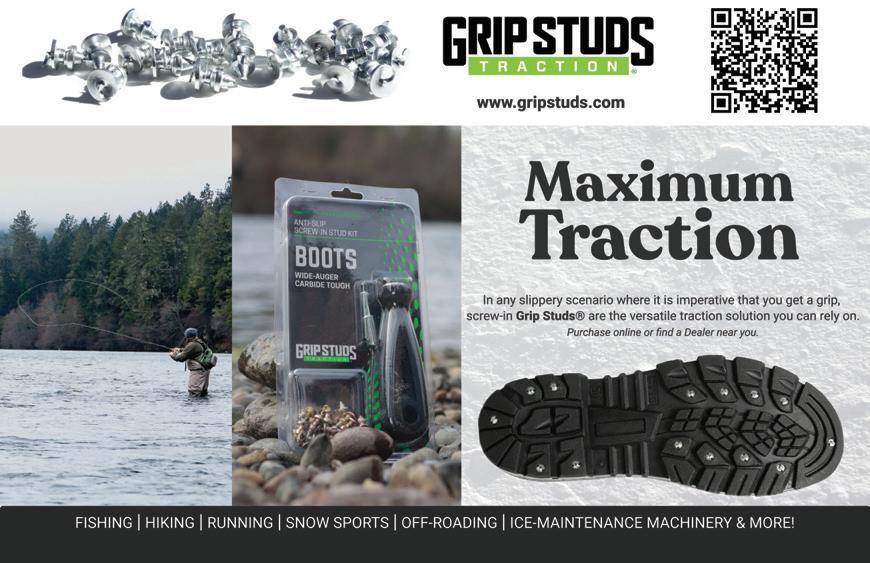
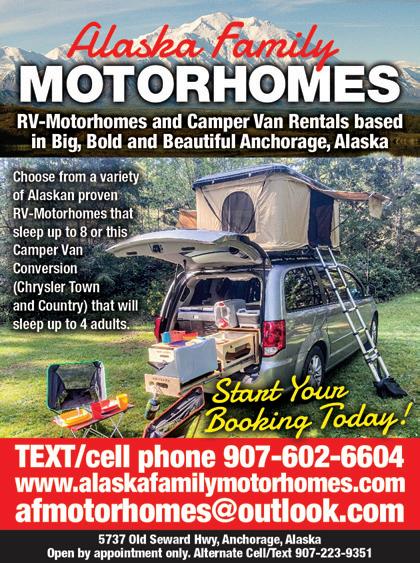

for the Crayon Eater that wants to make something special (Roasted in a peanut/tree nut FREE facility)



com

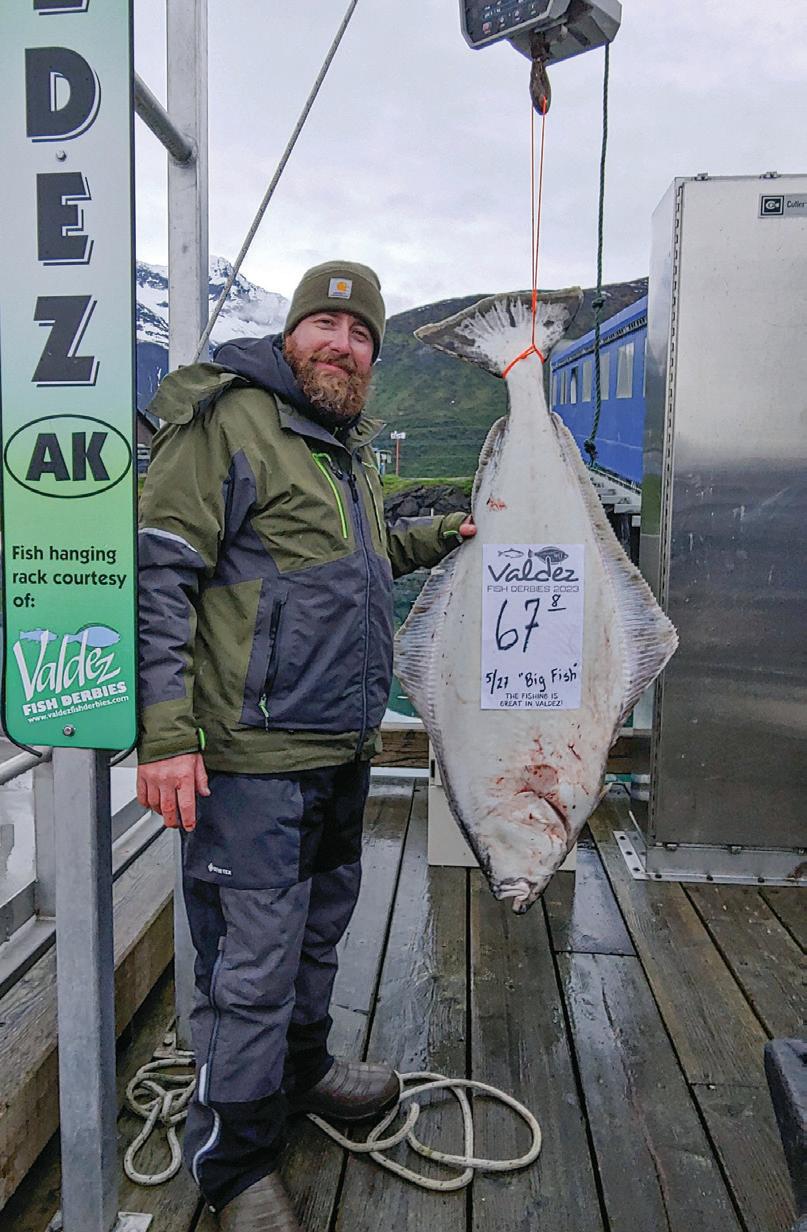
May 10
Spring brown bear season opens in Game Management Unit 10 (Aleutians)
May 13-Sept. 2
Homer Halibut Derby (homerhalibuttournament .com)
May 25
Last day of brown bear hunting in GMU 6D (Montague Island and remainder of unit)
May 25-Sept. 1
Valdez Halibut Derby (valdezfishderbies.com/ halibut-derby)
May 31
Brown bear season ends in several GMUs
June 7-16
Halibut Hullabaloo (valdezfishderbies.com/ halibut-derby/ halibut-hullaballoo)
June 15
Brown bear season ends in several GMUs
June 30
Black bear season ends in several GMUs
July 1
2024-25 hunting regulations go into effect
July 4
Mount Marathon Race, Seward (mountmarathon .com)
July 20
Valdez Kids’ Pink Salmon Derby (valdezfishderbies .com/kids-derby)
July 20-Sept. 1
Valdez Silver Salmon Derby (valdezfishderbies.com/ silver-derby)
July 26
Valdez Big Prize Friday (valdezfishderbies.com/ silver-derby/big-prize-fridays)
The Valdez Halibut Derby opens on May 25 and runs through September 1. The angler who catches the largest fish during the derby will win a $10,000 cash prize. Go to valdezfishderbies.com for more information. (VALDEZ FISH DERBIES)
For more information and season dates for Alaska hunts, go to adfg.alaska.gov/index .cfm?adfg=hunting.main.

The simplicity of fishing on Alaska’s Kenai Peninsula doesn’t magically cure a breast cancer diagnosis, but because of the nonprofit organization Casting for Recovery, retreats like these offer brave women suffering from the disease a cathartic escape from what they’ve been through. (MISSY SHOFNER SPROUSE/CASTING FOR RECOVERY)

Call it a momentary sense of normalcy, a much-needed distraction, a bonding experience, an opportunity to connect with nature. Therapy appears in various forms, shapes and sizes.

And in a setting such as wading in an Alaskan river, or boating down the Kenai on a misty fall morning, fly rod in hand, surrounded by women who are part of the same sisterhood – those who have received a breast cancer diagnosis – the simplicity of waiting for a trout to devour the fly at the end of the line during a most complicated time in life is cathartic, if only for brief moments. Catching fish isn’t the only endgame. Hardly.
Cancer sucks! Or as often-viral social media hashtags so eloquently put it: #F*ckcancer! There’s no sugarcoating that when a weekend fly fishing retreat is over, it’s not going to change a diagnosis. Casting for Recovery, the organization that offers free fly fishing retreats from coast to coast for women with breast cancer, understands that a weekend getaway can’t make it all go away, but it can provide a much-needed reprieve from the stress and worry that a cancer diagnosis brings. It can also offer perspective.
“‘The healing power of nature’ – a lot of our taglines have to do with that. And I believe that wholly,” says Jen Lofgren, Casting for Recovery senior regional program manager, who helps organize retreats in Alaska and other Western states.
“It’s just changing a thought, moving a muscle kind of thing. Get out there and allow yourself time to be in nature. I don’t know anyone who has ever said ’I feel worse’ after spending time in nature.”
What began as a modest idea in Manchester, Vermont, in 1996, has turned into a nationwide nonprofit organization that has served roughly 11,000 breast cancer survivors and thrivers to date. Indeed, Casting for Recovery has found a niche that it can be proud of.
“I know a lot of people who say, ’Oh, breast cancer; there’s a million resources for people with breast cancer.’ That’s true; there’s a lot of stuff out there. But nobody’s doing this. That’s what I hope keeps us relevant for years to come,” adds Lofgren, who also emphasizes the importance of reaching a more diverse audience. “I hope we can continue to do good work and serve people.”
The concept started small and became a big hit.
WANNA KNOW HOW FLY fishing and honoring breast cancer patients came together? A professional fly angler and a breast reconstruction surgeon, of course. Hence in 1996, the fly fisher, Gwenn Bogart (nee Perkins), and the
surgeon, Dr. Benita Walton, were good friends who had an inspiration.
“The surgeon said to the fishing guide friend, ’Take me out and show me what fly fishing is about,’” Lofgren says.
“And she soon realized that the gentle casting motion would be really good for patients who had undergone radiation and reconstructive surgery.”
Gwenn was affiliated with the popular outdoor retail company Orvis, which, Lofgren says, “didn’t hurt,” as it offered up new avenues to mold more than a common bond between two women.
“That was a good launching place, to have the support of Orvis, a giant in the fly fishing world, who agreed that it sounded like a great idea. In 1996, we started with two programs in Vermont, and then fast forward 28 years later and we will host 60 retreats across the country this year,” Lofgren says. “So it’s pretty awesome.”
Indeed, by the time you read this, there will be retreats either completed, in progress or planned from Casting for Recovery’s Vermont birthplace, to the state of Montana (the current location of CfR’s national headquarters), all the way to Alaska, with a maiden Hawaii retreat scheduled June 7-9 on the island of Kauai.
That there is even more demand to add more retreats to accommodate all the women interested in signing up is both great for outreach but also the reality of an abhorred disease.
“Sadly, we don’t have any shortage of clients. We all know wives, daughters, mothers, sisters, friends who have had a breast cancer diagnosis. And so we have more women applying than we can accommodate; for every one woman we accept in our random selection process, we turn three away,” Lofgren says. “So there’s definitely more need than there is bandwidth, which is good in terms of keeping the doors open, but frankly, I think we’d all agree that we’d take a cure for the disease and find something else to do.”
THIS YEAR’S KENAI PENINSULA retreat will take place September 6-8 at River Raven Sanctuary Lodge in Soldotna along the Kenai River. Lofgren has been involved with several Last Frontier events. As you might expect, the logistics for an Alaskan retreat can be quite challenging.
“It takes a hearty soul to live in Alaska for many reasons – remote location, harsh climate, extended periods of darkness and lightness, expensive housing, high cost of goods, and limited access to resources such as health care,” she says. “Many women diagnosed with breast cancer, especially those living in remote areas, have to travel quite a distance for their chemotherapy and radiation, sometimes all the way to Seattle. Travel is not inexpensive; figuring out housing is not easy or cheap if they need to find a place to stay for daily or weekly chemotherapy or radiation treatments (often for 6 weeks or more). Taking time off of work, arranging for childcare – these are all added stressors on top of receiving a cancer diagnosis.”
For these cancer patients who live in Alaska, the Casting for Recovery program provides desperately needed comfort, camaraderie and common ground.
“For many of these women, coming to a retreat is the first opportunity they have to discuss their diagnosis and treatment in any kind of a supportive setting, and it’s made all the more powerful because they are able to share with other women who are walking a similar path,” Lofgren adds. “Additionally, all of our retreats have medical and psychosocial facilitators who have experience working with breast cancer patients, so they are able to get informed information that they may not get from their local practitioner. These Alaskan retreats are so important. The women need the support.”
And now there are plans to host a special Alaskan Native-supported retreat in 2024-25. As Lofgren points out, many in the state’s Native communities lack medical and mental/behavioral health resources, and health care/insurance opportunities are frequently lacking.
At best, many women in Alaska’s tribal communities are underinsured, so you can imagine how such a hardship is magnified by a cancer diagnosis.
“This is part of a larger effort at Casting for Recovery to reach underserved populations of women who have experienced breast cancer and are disproportionately affected by the disease,” says Susan Gaetz, the organization’s executive director.
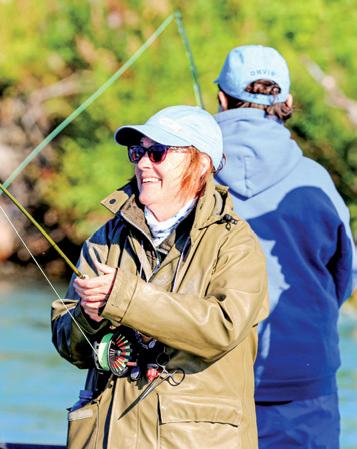


In addition to this annual Kenai retreat, Casting for Recovery is planning a first-ever event geared toward Alaskan Native women. “This is part of a larger effort at Casting for Recovery to reach underserved populations of women who have experienced breast cancer and are disproportionately affected by the disease,” says Susan Gaetz, the organization’s executive director. (MISSY SHOFNER SPROUSE/ CASTING FOR RECOVERY)
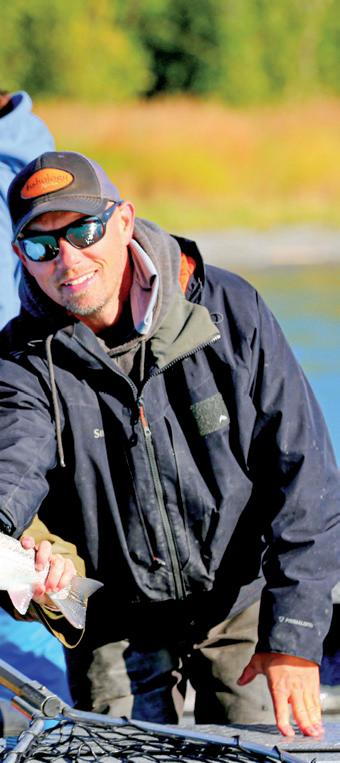

Jen Lofgren (left, helping a participant cast) had always wanted to volunteer for the program, and after meeting a Casting for Recovery representative she eventually became a full-timer for the organization. “I just fell in love with it. I thought it was the most amazing thing,” she says. (JEN LOFGREN/CASTING FOR RECOVERY)
“The success of the Alaska Native Women’s retreat is dependent on it being led by Alaska Native women with support from Casting for Recovery. We recently identified our retreat leader and are securing our venue. We have also been working with the native population for outreach efforts and volunteer recruitment,” Gaetz states.
WHAT KEEPS CASTING FOR Recovery
churning along are its volunteers, generous individuals who give their time and talents to run these retreats. Each program is run by a team of volunteers, from program and participant coordinators, wellness professionals, hospitality, fishing guides and photographers. Each program is fully self-supporting and does all of its own fundraising throughout the year in order to host these retreats. CfR has over 1,800 volunteers nationwide! Lofgren was one.
A longtime angler, she was managing an Orvis store in Denver in 2012 when she heard about Casting For Recovery and wanted to help. As it turns out, someone representing the organization walked into the store in search of donation options.
“I said, ‘I’d really like to get involved,’ and she said, ’Well, we need guides for this weekend.’ And that’s how it all started, and I just fell in love with it. I thought it was the most amazing thing,” says Lofgren, who after years of volunteer work took a fulltime position with the nonprofit in 2018. “And now what I get to do is work with all of the programs in the Western states, and as I jokingly like to say, the West is best! Seriously, though, I feel so incredibly fortunate to be able to do what I do.”
Lofgren says her Alaska trips to the Kenai Peninsula have been among the most memorable of the Western states’ retreats.
“People go through a lot and it’s really eye-opening to see how strong people are, and not just the person diagnosed with cancer, but their families and support systems as well. It’s really impactful.”
Lindsay Agness is another Casting for Recovery volunteer. Based near Rochester, New York, she and husband Dave have collaborated to write fishing books, and the couple regularly casts for salmon, trout and Arctic char in Alaska (Alaska Sporting Journal, June 2023).
Agness, who also volunteers in Trout
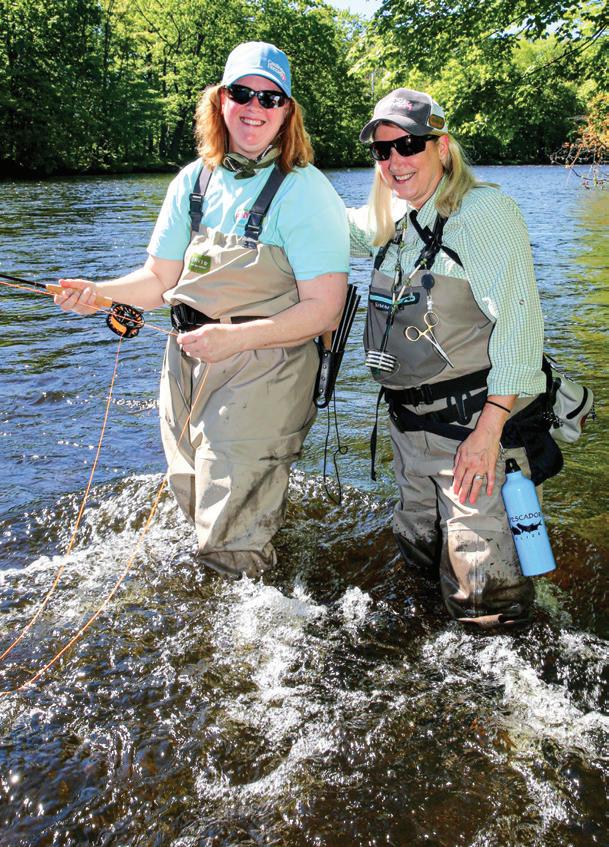
Unlimited’s Women’s Initiative program and participates in fishing-related programs for veterans and kids, has been involved with Casting for Recovery’s upstate New York chapter retreats since 2015 as a fly fishing instructor.
“Casting for Recovery has been such a wonderful organization and it has impacted me tremendously. I get more out of the retreat weekend than you can imagine,” she says. “These 14 women who attend the retreat have lots of health issues and trauma. They show me how to move past a traumatic cancer experience and live every day to the fullest. The women I meet are an inspiration to me and make my problems seem small and
minute compared to what they face every day. It’s been an honor to guide these women over the years.”
Agness can attest to the power that these retreats can have for those stricken with cancer.
“Many times, women are diagnosed with breast cancer, and they don’t have a chance to go through their emotional journey. They have surgery and followup treatments. However, they are left with their grief and feelings that need to be addressed,” she says. “This program and retreat allows them to meet with other women going through a similar journey. The emotional benefits of being with others in a similar situation while
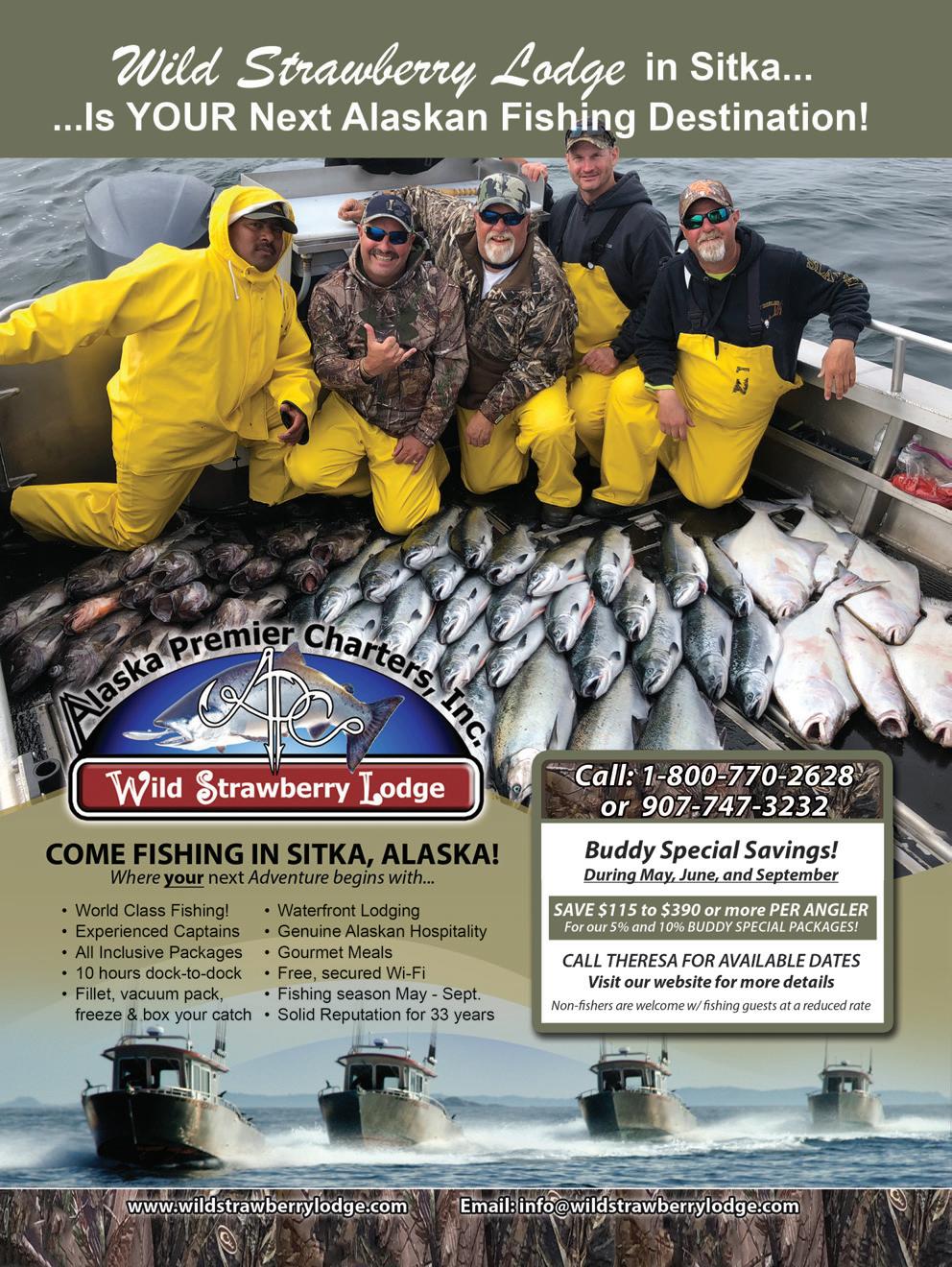

Agness, who volunteers for retreats in upstate and western New York, is inspired by every cancer patient who attends and participates in the program. “The emotional benefits of being with others in a similar situation while connecting to nature is very healing. There is a lot of laughter, crying, hugging and support at the retreat. At the end of the weekend, the women have bonded for life.” (LINDSAY AGNESS/ CASTING FOR RECOVERY)
connecting to nature is very healing. There is a lot of laughter, crying, hugging and support at the retreat. At the end of the weekend, the women have bonded for life.”
Lofgren cherishes the friendships she’s developed over time with both retreat participants and volunteers. One particular relationship she’s grateful for was with Margaret Bell, who attended a retreat that Lofgren helped coordinate in Colorado.
Margaret eventually became a volunteer herself.
It’s that kind of pay-it-forward approach that has made this organization grow exponentially. Connections made over the weekend can become lifelong friendships.
Margaret wrote a recap of her retreat experience and one of the things she said was, “We show up for the weekend and we all have this common language – chemo, radiation, infusion – and as the weekend progresses we’ve got this new vernacular, like thingamabobber and tippet, all these new words that are being incorporated into the weekend, an example of how these retreats allow women to think about something other than cancer, if only temporarily.”
Margaret passed away on October 10, 2022, but her spirit will remain with
her friend forever.
“I can say with absolute certainty that her quality of life greatly improved after she attended a retreat. She completely fell in love with the sport of fly fishing, and volunteering for this organization became her passion. She recognized immediately that being in nature, fly fishing with new friends, was the one place that she did not think about how sick she was. As a result, she wanted to go as often as she could.
Two weeks before she passed away, she was fishing in Montana. It meant everything to her,” Lofgren says.
Fear of recurrence goes along with this disease that has affected so many people. #F@uckcancer, indeed. (Casting For Recovery also hosts metastatic retreats for women suffering from stage four cancer in Colorado, Georgia, Indiana and Texas; Nebraska just hosted its first stage 4 retreat last month and Idaho will host its first in September.)
“We offer medical and emotional wellness sessions, where participants are given the opportunity to speak openly about their disease, and ask questions in a safe space. They can even do so anonymously by putting a question into a basket about something they might not feel comfortable saying out loud or
discussing with their oncologist. A lot of times people have a hard time talking to their own family because they don’t want to scare them,” Lofgren says. “They just have to navigate some things, and being able to do that with other women who are in a similar situation allows them the freedom to do that.”
During free time, many of the women gather with one another, and even with staff, to continue the conversations.
AS FOR THE FISHING, many of the applicants have little, if any, angling background. Fly fishing experience is almost nonexistent, but it is also not a requirement.
“The lion’s share of those attending our retreats have never picked up a fly rod before. And many of them have never tried traditional or conventional fishing either, or if they have, it was when they were a child. So we really spend a good part of the weekend teaching them,” Lofgren says. “They usually show up on a Friday afternoon and we get them outfitted in their gear right away, and that’s kind of a good icebreaker – trying on waders and posing for a grip and grin with a giant stuffed trout.”
“On Saturday morning, we do a basic introduction to the sport – equipment


sculpin tubes and jigs generate bites from creating subtle flashes and movements from the jig’s innovative pectoral fins
opening the fins by dropping the jig only a few inches keeps you in the zone and stimulates strikes
made in palmer, alaska, these jigs are designed to be alaska tough


Drastically improve performance and steering of bow-mounted electric trolling motors with the LeeLock Magnum Skeg. The use of bow-mounted electric trolling motors for salmon trolling is a game changer. Not only does this skeg improve performance, it makes bow-mounted electric trolling motors much more efficient. Your batteries will run longer on a charge. The LeeLock Magnum Skeg can be a vital part of your trolling motor system!
The skeg is made of anodized 5052 aluminum. The size is 8 3/4 inches high by 10 inches wide and it’s 3/16 inch thick. The anodization keeps the aluminum from corroding in fresh- and saltwater. The LeeLock Magnum Skeg is available to fit most Minn Kota and MotorGuide (pictured) motors. It comes with clear PVC-coated stainless steel hose clamps. Call 360-380-1864 or write info@ leelock.com if you have any questions about fit.
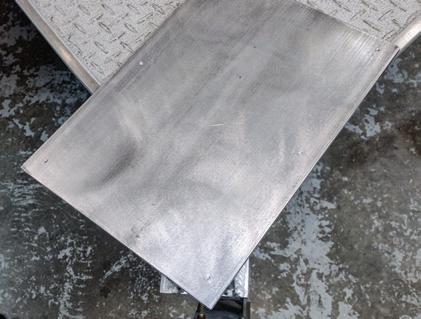

columbiarivertackle.com

This new Leelock Motor Mount is designed for the Minn-Kota Quest series of motors. The mount will fit in any of the LeeLock Anchor System Bases. The mount will be available angled to the port or starboard side. Simply slide your Motor Mount on the base and lock it in with the pin. An optional locking pin is also available to prevent the motor from being stolen.
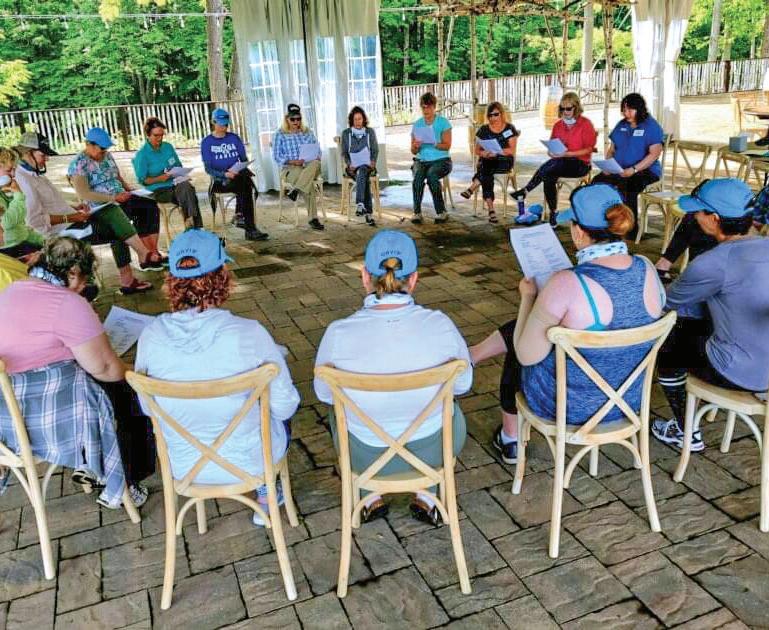
overview, knots and rigging, how to put a rod and reel together, explain the gear, accessories, rod weights, lines, tippet, accessories, etc.,” she continues. “And in the afternoon, we teach basic casting, wading safety, how to fight a fish and proper catch-and-release techniques. Some programs offer fly tying, so women get an opportunity to try that out, and maybe even catch a fish on a fly they tied!”
“And then Sunday comes – the most exciting day of the retreat, in my opinion. Each woman is paired with her own guide and the two of them spend four to five hours fishing. The laughter, smiles and hooping and hollering that can be heard echoing across the water is the most beautiful sound you’ll ever hear.”
By the end of the weekend, Lofgren is often amazed and heartened by a newfound love for fishing and the outdoors.
The day ends with lunch and a graduation ceremony, and then everyone says their goodbyes.
Lofgren is pleased to note that the comment she hears most often from participants after the retreat is “I wish it had been longer. I didn’t want to leave; it should be a week long.”
“That tells me we’re doing something right,” she says.
WHEN THE PIONEERS OF Casting for Recovery, Dr. Benita Walton and Gwenn
Bogart, teamed up on the idea for the program, they soon discovered that at its core, the fly fishing premise was on its own a healing placebo for breast cancer patients. That is in the casting motion of a fly rod and how it impacts and improves mobility.
“That’s something that (Dr. Walton) noted right out of the gate, and that’s sort of the idea that was born about why fly fishing and breast cancer (are connected),” Lofgren explains. “A lot of people wondered just that. ’What does fly fishing have to do with breast cancer?’
And even if it didn’t have to do with mobility or movement, I think it would be just being outside and the soothing sounds of the water. And casting; I just love to cast. I find it really relaxing, just the rhythmic cadence of it And I do think it’s a great motion for mobility, even for myself.”
Lofgren notices that rookies often will grasp a fly rod really firmly, as if they’re handling a rattlesnake, and they quickly tire, but as soon as they start to relax and get the hang of the timing and the casting motion, things start to come together for them.
Lofgren has also found that women teaching other women to fly fish makes it an even smoother transition.
She says that generally speaking, women are great casters because “A) They listen pretty well, and B) They don’t
try to hammer the cast. It’s so much more of a finesse thing than a power thing – a gentle, even motion. And it’s a lot easier in my experience to teach a woman how to cast than it is a man, which I realize is a broad generalization, but many men think it’s a power stroke. But by and large, it’s a finesse thing.”
Besides the therapy and positive vibes the retreats offer, Lofgren believes it’s important that the organization is always evolving and cognizant of factors like climate change and its effect on outdoor recreation. She cited the uptick in devastating wildfires, drought and floods in the West, not to mention the deadly blaze that struck the Hawaiian island of Maui in August 2023.
The retreats are also an opportunity to provide the women with a conduit between fishing and conservation. Casting for Recovery has made it a point to preach the catch-and-release ethic at its retreats.
“Conservation is so important when introducing women to the sport of fly fishing, and we want to do so in a responsible and sustainable fashion. There is a big movement right now to ‘Keep Fish Wet,’” she says, “and we recognize the importance of doing so, but with brandnew anglers, they’re so excited that they often manhandle the fish. We understand we need to show them the right way to do it. Explain why it’s important to handle fish more carefully and to keep them in the water as much as possible. We also try to impart the importance of maintaining our natural resources so that they are there for generations to come. That, and being good stewards of the land that we’re using is important. We all have a responsibility.”
Melissa and Carol discussed their experiences with Casting for Recovery programs as retreat participants.
Michelle: “I had just had a double mastectomy and I wasn’t sure I would be able to participate in activities like this. I surprised myself and I am so grateful to have been able to participate in this retreat. It was a life-changing experience for me.”
Melissa: “After I was diagnosed with cancer, I lost my connection with nature. I forgot about the revitalizing effects it has. Being able to take deep, clean breaths,





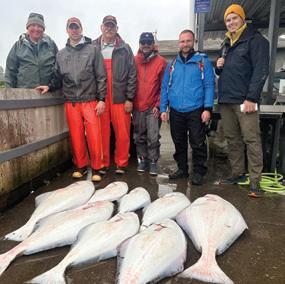
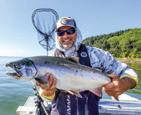




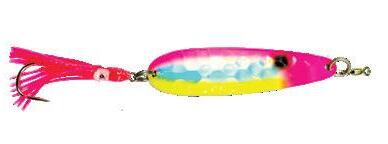



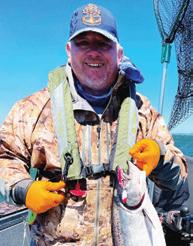

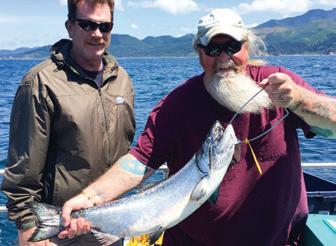
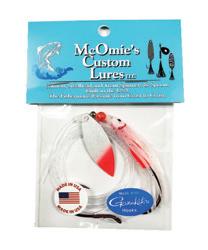
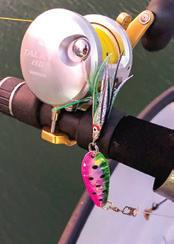
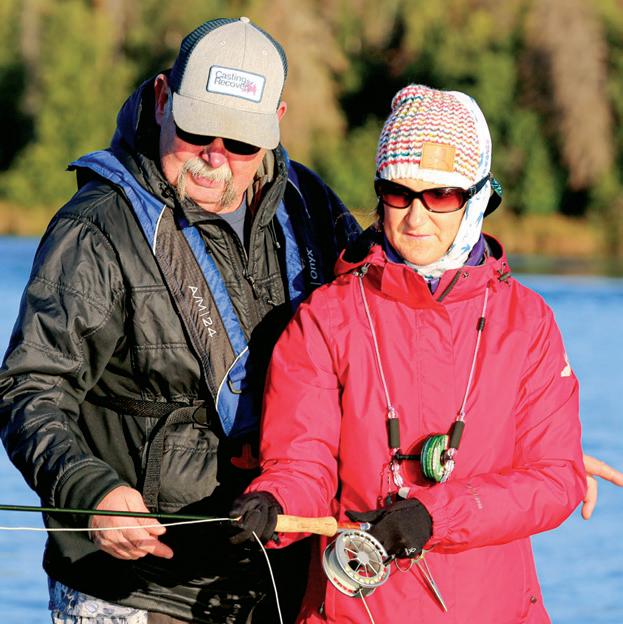
The retreats also act as a conduit between fishing and conservation. Roughly 11,000 women have participated in the program. (MISSY SHOFNER SPROUSE/CASTING FOR RECOVERY)
enjoy the brisk morning air and feel the sun on my face as the day warmed was so healing and uplifting. Casting for Recovery reminded me how much I need nature to survive.”
Carol: “I had never been fly fishing. I’m a pretty outdoorsy person, but this was a new experience and I enjoyed the beauty of the river, the company, and I was surprised to catch so many fish and release them back. It was overwhelming at times to be in the company of all of these amazing women with breast cancer. The fishing made that possible.”
Lofgren often reminisces about her friendship with Margaret Bell, the Colorado retreat participant who started volunteering with Casting for Recovery after she attended a retreat. “Margaret’s cancer journey is over,” Lofgren says, “but she will be remembered as a positive and joyful force, and everyone whose lives she touched is better for having known her.” ASJ
Editor’s note: Learn more about volunteering or donating to Casting for Recovery at its website, castingforrecovery.org.






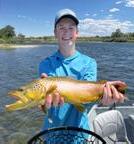
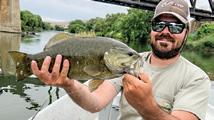
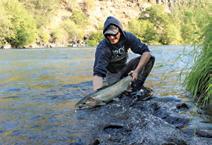

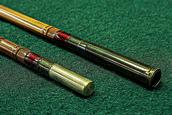


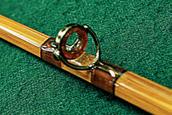
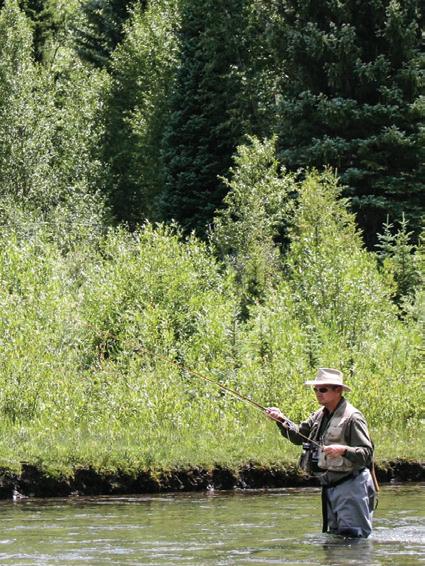


After the rebooted Homer
stretched across all of June in 2023, this year’s
will run from May 13 through September 2.
Halibut Derby event (HOMER HALIBUT DERBY)Homer’s new-look halibut tournament is stretching its legs this spring and summer.
After retiring its 30-plus-year weekend Jackpot Halibut Derby in 2019, a new, longer event – the Homer Halibut Derby – was introduced in 2023 (Alaska Sporting Journal, June 2023). Last year’s debut was a bit of a test run to see how a longer event could function.
“Last year, the derby ran just during the month of June as we tested the new software system and weigh-in process. The system worked very well, so we are rolling it out to a larger time frame this summer,” says Brad Anderson, executive director of the Homer Chamber of Commerce.
The derby now begins May 13 and runs all the way through September 2, Labor Day Monday.
“With this new version of the derby, daily tickets can be purchased online up until 8 a.m. on the day of fishing, and we have added a weekly prize element,” Anderson adds.
One of the signature events of Alaska’s fishing calendar is the Homer Winter King Salmon Tournament, a one-day frenzy of fishing boats heading out onto Cook Inlet and Kachemak Bay in search of a payday fish that culminates with weigh-ins and trophy ceremonies back at the port.
The tournament is a popular event for
“Fishing is a big part of the local economy for Homer, and we are world-renowned for our halibut fishing,” says Brad Anderson, executive director of the Homer Chamber of Commerce. “Last year, the derby ran just during the month of June as we tested the new software system and weigh-in process. The system worked very well, so we are rolling it out to a larger time frame this summer.” (HOMER HALIBUT DERBY)
FOLLOWING LAST YEAR’S TRIAL RUN AS A MONTHLONG EVENT, HOMER’S FLATTIE TOURNEY HAS EXPANDED FROM MAY TO SEPTEMBER


Alaskans, who, after enduring the usual dark and cold winter, can gear up for the arrival of fishing and tourist seasons later in the spring and summer.
“The Winter King Tournament has become the largest fishing event in Alaska, so it takes a tremendous amount of planning and staffing to pull it all off,” Anderson says. “This is a much simpler event to coordinate, as everything is basically done on the tournament website, homerhalibuttournament.com, and it extends over a longer time frame. We will be working in partnership with the Homer Charter Association, so those fishing charters will greatly help get their clients connected to the derby.”
It’s an easy prospect to get signed into the derby anytime between the opening
day on May 13 all the way through September 2. A daily ticket costs $40.
“You must purchase your daily derby ticket by 8 a.m. on the day you plan to go fishing. That is all you need to do to get entered into the derby. There will be prizes for the largest halibut caught each week and for the largest caught by the end of the derby,” Anderson says.
“There is also a Released Fish category if you choose to release a 48-inch or larger fish. A random winner will be selected from that category and will receive a cash prize of $1,000.”
According to the derby’s official rules, “All fish entries with a derby ticket must be brought in and/or weighed between 2-6 p.m. on the day caught. The minimum size to be weighed is 55 inches. Participating anglers must be accompanied by a witness (preferred captain or
deckhand) to testify that the fish was caught following official derby rules. Anglers entering and weighing fish at Derby Headquarters must complete all official forms. Weighing must be done according to standard derby procedure and certified by a weigh-in official.”
The weekly derby runs Mondays through Sundays throughout the tournament. If no halibut caught and recorded during the week is over 55 inches, the cash prize amount carries over to the following week.
June also marks the Homer Halibut Festival, which features two big events on the calendar. The June 20 Homer Summer Solstice festival will be one of the busier times of the season in the port city.
“It will take place at the Homer Chamber of Commerce property and will feature live music, a beer garden, a deckhand skills contest, food trucks, vendors and a street fair,” Anderson says.
After the conclusion of the seasonlong halibut derby is the Big ’But Ball, scheduled for Saturday, September 7.
“This is a fun-filled evening of food, music and dancing to celebrate the end of the summer fishing season and pay tribute to Homer’s designation as the Halibut Fishing Capital of the world,” Anderson adds.
Anderson says Homer’s halibut are around most of the year, but fishing should be solid throughout the duration of the derby.
And as locals around Homer and the Kenai Peninsula, other instate residents and Lower 48 visitors will attest, the port area and beyond should be buzzing throughout late spring and summer.
“Fishing is a big part of the local economy for Homer, and we are world-renowned for our halibut fishing. However, Homer is also the top bear-viewing region in Alaska,” Anderson adds. “There is a thriving culinary scene led by our fresh seafood, our arts community was just recognized by USA Today as the fourth best small arts town in America and we are blessed with some of the most stunningly beautiful views anywhere in Alaska.” ASJ
Editor’s note: To learn more about visiting Homer, go to homeralaska.org.

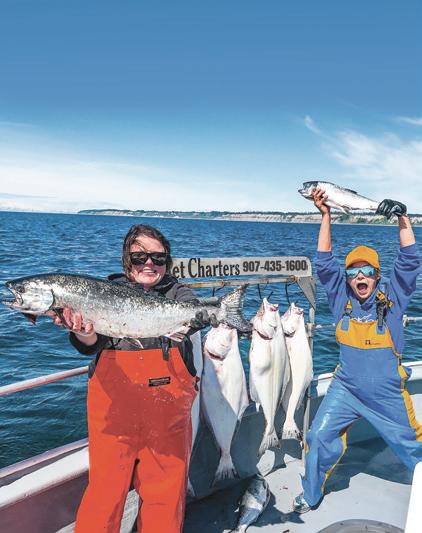
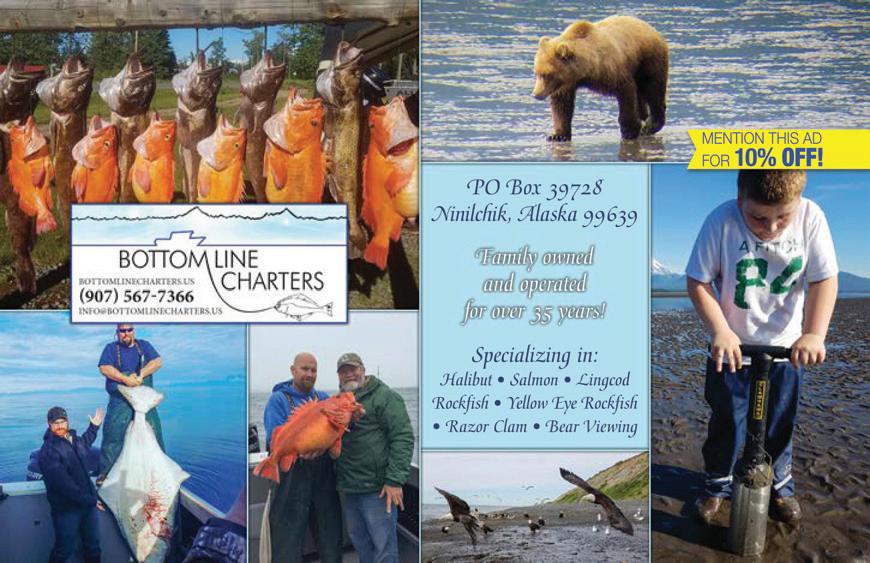
Caribou are among the myriad wildlife and fish species that will benefit from recently announced federal protections for 13 million acres of the National Petroleum Reserve in Alaska and the denial of a permit to build the 211-mile-long Ambler Road on the other side of the Brooks Range. The latter project would connect the Dalton Highway to the Ambler Mining District and cross caribou calving grounds. (BOB WICK/BUREAU OF LAND MANAGEMENT)
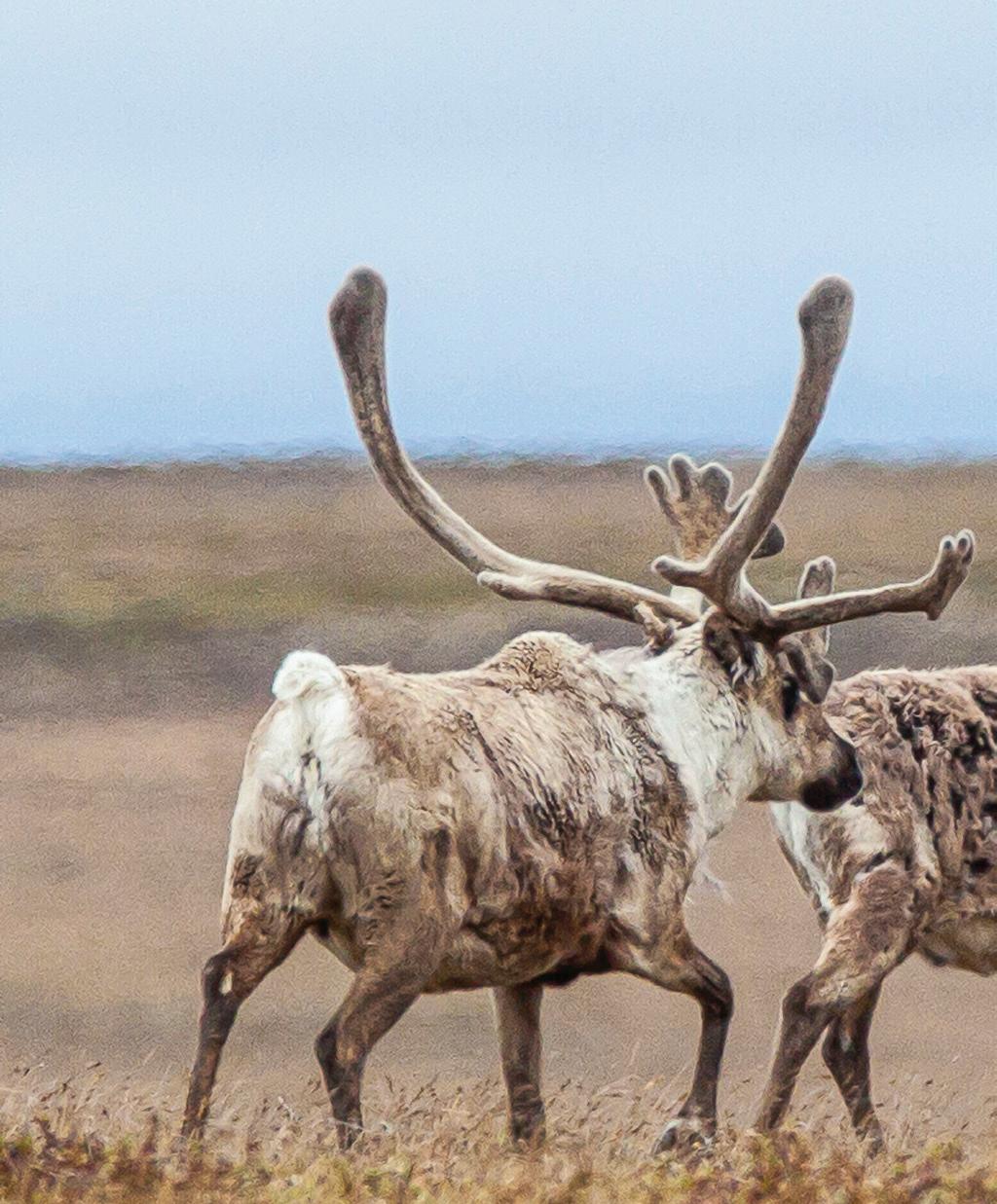
 BY CHRIS COCOLES
BY CHRIS COCOLES
April was a good month for those who object to controversial mining projects.
In addition to another strike against the Pebble Mine after the US Army Corps of Engineers refused an appeal of its permit denial (see page 44), the Ambler Road, a 211-mile gravel path that would connect the Dalton Highway to a mining district to the west, also suffered a setback at the federal level.
Conservationists and Native groups say the industrial road would affect multiple natural resources if built, including wildlife along the Brooks Range and Gates of the Arctic National Park and migrating salmon in the Kobuk River. And on the heels of an American Rivers study that ranked the Kobuk nationally as the eighth most threatened stream due to the threat of the Ambler Road, President Joe Biden’s administration moved to block the route from being completed.
Despite bipartisan support from Alaska’s leading politicians in Washington for the project, the Department of the Interior essentially declined to permit the road proposed by the Alaska Industrial Development and Export Authority. Twenty-four percent of the road would cross federal lands.
As word of that pending decision began to leak to the press in mid-April, Alaska-based Ambler Metals LLC, which is spearheading the project along with

Canadian company Trilogy Metals, used the term “stunned” in a statement.
“If true, this decision ignores the support of local communities for this project, while denying jobs for Alaskans and critical revenues for a region where youth are being forced to leave because of a lack of opportunity,” said Kaleb Froehlich, managing director for Ambler Metals. “A denial would also undermine the promise made to Alaskans in the Alaska National Interest Lands Conservation Act, which guaranteed a right-of-way for this crucial project. We strongly urge (Bureau of Land Management) to reconsider what would clearly be an unlawful and politically motivated decision that goes well beyond the narrow set of issues the courts agreed to allow the agency to address.”
On the flip side, American Rivers’ rankings said this about the potential impact to the Kobuk, an important Interior subsistence and sport fishery in Western Alaska: “The proposed Ambler Road and associated mining development would cause irreparable harm to the Kobuk’s water quality and fish and wildlife, threatening communities all along the river. The Biden Administration must revoke all permits allowing construction of the road.”
Among the most vocal opponents of the road’s construction are Alaska tribal communities that rely on the Kobuk and surrounding areas for subsistence fishing and hunting.
“I’ve had the privilege of being raised in a very amazing place,” said Tanana first chief Julie Roberts. “I’m Neltsene; I come from the bear clan. My (grandmother) was from the Koyukuk River. I was raised along the Yukon River, a river that provides so much to our way of life. Alaska is one of the most pristine places in this world and I feel obligated to protect this for our future generations.”
Even as partisan politics dominate many federal- and state-level issues across the country, support for the Ambler Mining District and a road to it has come from both sides of the aisle in Alaska. The state’s lone US House member, Democrat Mary Peltola, is in lockstep with Alaska Republican Senators Dan Sullivan and Lisa Murkowski. The trio made a joint statement after both the Ambler Road project decision and a final ruling for the Natural Petroleum Reserve in Alaska were announced. The latter
would prohibit “leasing and infrastructure development on millions of acres of the petroleum reserve and threatens access to millions more,” per the Sullivan/ Murkowski/Peltola press release.
“The Ambler Road decision is premature, as real conversations among stakeholders in the region are ongoing,” Peltola said. “Alaska has a wealth of natural resources that can be responsibly developed to help boost domestic manufacturing and innovation; in the end, it should be up to Alaskans to decide what they want developed in their regions.”
Murkowski vowed she’d work with her Senate colleague Sullivan and Rep. Peltola to overturn the federal government’s decisions.
“At this point, the Biden Administration is undermining the rule of law, ignoring the voices of Alaska Natives, and punishing Alaska despite our strong environmental record,” she said.
Sullivan has been a frequent critic of Biden’s term in the White House, and he didn’t hold back, saying the administration was “deliberately undertaking policies to punish Americans and undermine our strengths while continuing to help our adversaries. Shutting down two of the

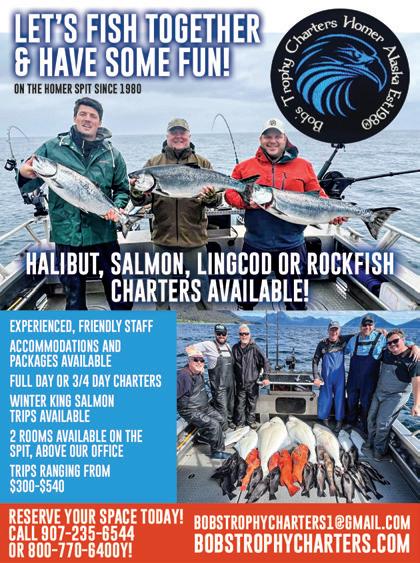
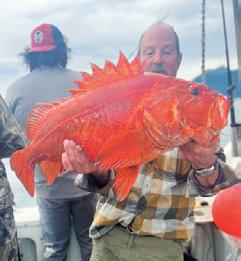



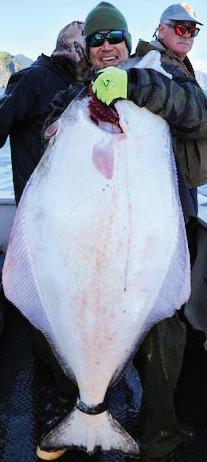




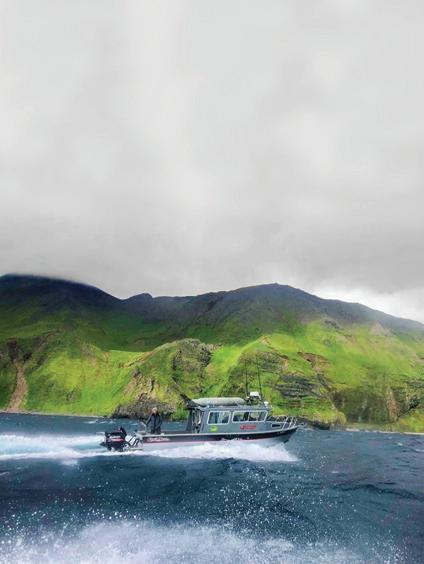
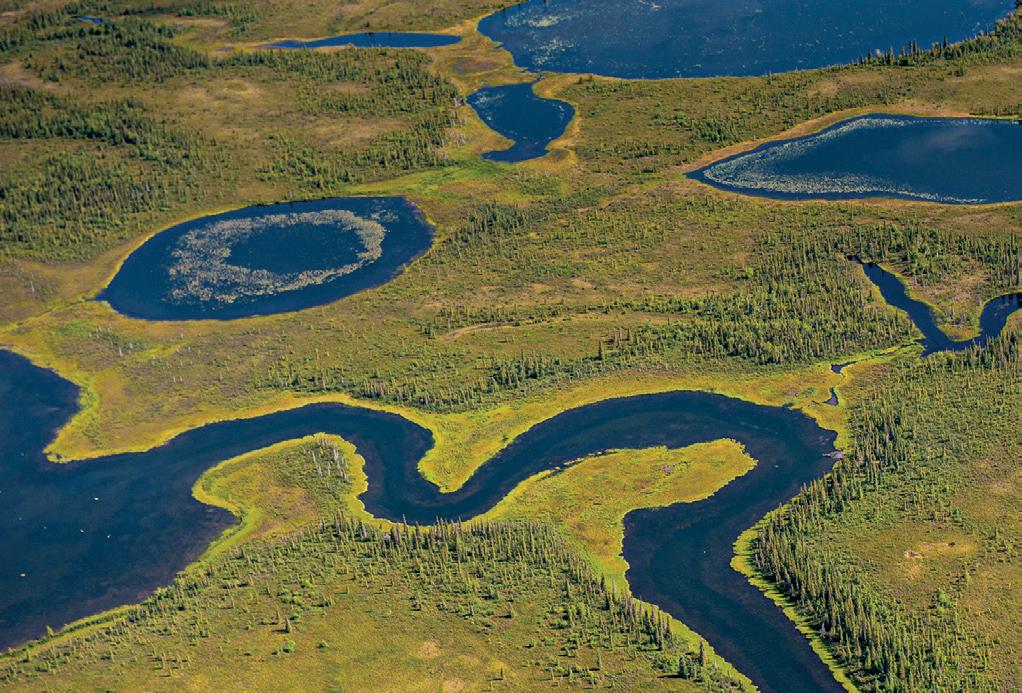
The Kobuk River is one of 3,000-plus streams the Ambler Road would cross, providing a strong argument against permitting it due to potential threats to fish. “Brooks Range rivers are beautiful, wild, and there are few other places like them in the world,” Alaska fly fishing guide Greg Halbach said. “Roads are the very opposite of remote and wild.” (NEAL HERBERT/NATIONAL PARK SERVICE)
world’s most important energy and critical mineral developments in our country sends this message to the dictators in Iran, China and Russia: ’We won’t use our resources to strengthen America, but we’ll become more dependent on yours,’” Sullivan said. “In their statements, both President Biden and Interior Secretary (Deb) Haaland say they’re taking such actions after extensive consultation and to ’(safeguard) the way of life’ for Alaska Natives. These statements are flat-out lies.”
“This decision goes against the strong opposition of the elected Alaska Native leaders from the North Slope Borough region, whose voices throughout this process have been canceled. In fact, the elected Indigenous leaders from the North Slope of Alaska have flown 4,000 miles to DC eight times, requesting a meeting with Interior Secretary Haaland to express their vehement opposition to the administration’s new (National Petroleum Reserve in Alaska) rule. Each
time, they were denied a meeting.”
Still, other Native luminaries in the region celebrated the decision to not permit the Ambler Road.
“The Evansville Tribal Council has been fighting the proposed Ambler Road for at least eight years. We were told that a 211-mile road was going to be built and that we would love it. This couldn’t be further from the truth,” said first chief Frank Thompson of Evansville Village.
“Today is a day that our future looks bright without the threat of 168 trucks driving by per day, without the increased pressures on our subsistence resources and imminent adverse risks to our traditional way of life and sacred cultural resources.”
While proponents of the Ambler Road and other mining and drilling operations cite the increased jobs that come with them, other businesses in and around the area where the road would be constructed
have a differing opinion. And many were pleased with the news.
“Brooks Range rivers are beautiful, wild, and there are few other places like them in the world,” said fishing guide Greg Halbach of Remote Waters. “Roads are the very opposite of remote and wild. A single road can fragment habitat, disrupt wildlife migrations, and introduce chemical pollutants on a scale much wider than the narrow strip of gravel that we see. A float down the Kobuk River that included passing under bridges and listening to the hammering of engine brakes from tractor-trailers would be a radically different recreational experience.”
In its final supplemental Environmental Impact Statement for the Ambler Road project, BLM “identified ’No Action’ as its preferred alternative, finding that each of the other alternatives would significantly and irrevocably impact resources, including those supporting important subsistence uses, in ways that

cannot be adequately mitigated,” the federal agency said.
Secretary Haaland concluded that Alaskan Native people who rely on subsistence hunting and fishing in the region were a big reason why the road was rejected, “safeguarding the way of life for the Indigenous people who have called this special place home since time immemorial.”
Many others in Alaska were also celebrating the decision.
“This milestone is the result of broad opposition to this project, led by local residents and Alaska Native Tribes, and supported by thousands of conservationminded hunters and anglers from across the country,” said Jen Leahy, Theodore Roosevelt Conservation Partnership Alaska senior program manager.
“Those sportsmen and sportswomen have helped turn the tide of public opinion against the Ambler Road,” she added, “and we appreciate the BLM recognizing this in their preferred alternative.” ASJ

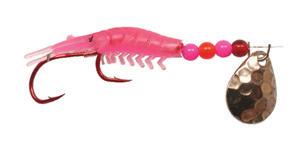
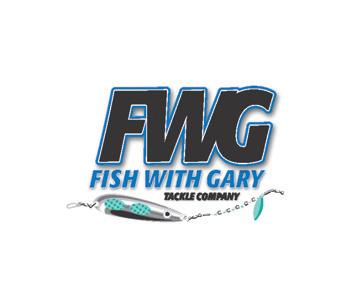



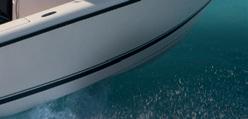









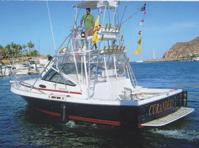

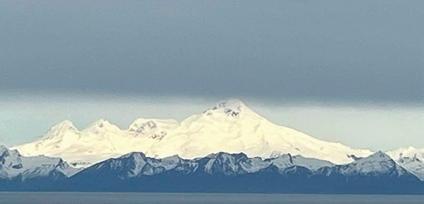
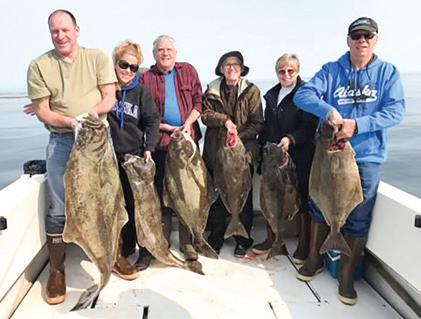



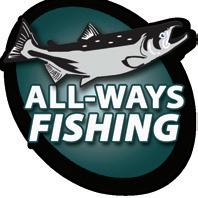


No matter where you hunt bears in Alaska, long grueling hours of glassing play a major part in the hunt. Here, outfitter Bruce Hallingstad and author Scott Haugen search for coastal brown bears. (SCOTT HAUGEN)

As the smell of fresh bacon wafted through the tent, I crawled from the sleeping bag, poked my head out the door and began glassing.
Gazing across the marshy flats below, I spotted a black bear on the move. In the hills above, another bear frolicked, munching on the bountiful crop of wild blueberries. On a distant ridge –impossible to reach from our position – a
third bear was feeding on berries. Things were off to a promising start.
Over the course of the day, my hunting partner Tom Munson and I would see three more black bears and two nice grizzlies. It was August and we were hunting in Southwest Alaska’s Game Management Unit 19, near the village of Sleetmute, with outfitter Curly Warren of Stoney River Lodge. Joe, our veteran guide
of more than 25 years, encouraged us to wait in hopes of finding a bigger black bear (both Tom and I held a black bear tag).
With so much daylight this time of year, accumulating hunting hours was the least of our concerns. Up the hills we’d climb, glassing as we went and searching for bears. When bears were located, we’d break out the spotting scopes and size them up.
Despite what many people may think, brown bears aren’t around every corner in remote Alaska. Hunts can take days, even seasons to find success. Haugen has endured plenty of such adventures. (SCOTT HAUGEN)

“Ya know, this is my first bear hunt and I really don’t care how big of one I get,” noted Tom as we glassed a lone bear high atop a ridge. The bruin was tucked into a small bowl on a south-facing slope, feeding on berries.
“This one won’t go 6 feet, but if you’d like, we can give it a try,” offered Joe. That was all Tom needed to hear. Soon we were off on another hike, admiring the beauty of the rolling tundra along the way. The day was clear, calm and breathtaking – more good reasons that today would be a good day to get a bear.
After more than an hour of climbing, Tom was finally within 300 yards of the bear. Then suddenly, the wind shifted and carried our scent straight up the draw. Just like that, the jig was up as the bear sprinted over the next ridge.
“Let’s go see if we can find it,” Joe encouraged. Two hours later, we were at the top of the steep, shale-covered ridge where we’d last seen the bear. Peering on the opposite side of the peak, it was rock for as far as the eye could see. But just
over a mile away we saw a bear. It was walking our direction, so we sat, waited and watched to see what it would do.
Thirty minutes later, the first bear we were after joined the bear we’d been watching. For more than two hours the duo chased and played, but they continued slowly moving in our direction. “They’re coming back to the berry patch,” Joe said with a smile. “Let’s just sit right here and see what happens.”
I’d taken many bears, so I wasn’t too picky about what size bruin I pulled the trigger on. I also love eating bear meat, especially from animals taken this time of year. In addition, I was chomping at the bit to get off the mountain and experience the world-class northern pike and sheefish action Stoney River Lodge is noted for.
“If both bears get close enough, you shoot the first one and I’ll take the second,” I offered Tom.
Tom, the director of marketing for Trijicon at the time of this hunt, was
using their new 5-20x50 scope mounted atop his .300 Winchester Magnum. I was hoping to be the first to take an animal with their new green triangle reticle from their AccuPoint line. Of all the animals I’ve been fortunate to hunt using Trijicon scopes around the world, black bears are among the most fitting for the glowing reticle. Oftentimes, properly placing a thin black crosshair on a black bear hide can be challenging, which is where the illuminated fiber optic really shines.
At just over 400 yards away we waited, wanting the bears to get closer. When they disappeared into a deep draw below us, we lost sight of them for nearly 20 minutes. “They should be close,” Joe whispered. We could see the top and bottom of the valley in which the bears had descended, so knew they’d hadn’t left.
“Don’t move,” Joe whispered, head down, pointing with the bill of his cap. “They’re right there!”
I carefully looked up and saw the backs of both bears, 40 yards away. Slowly, quietly, Tom and I raised up and shouldered the guns. As soon as Tom pulled the trigger,

his bear dropped. A split second later, my .30 T/C sent a 165-grain bullet into the shoulder of the second bear. Both bears were down, 10 yards from one another.
After having watched these bears for more than three hours, the final moments had happened fast. Perched atop the rocky slopes, we couldn’t have asked for a more breathtaking view of Alaska’s wild lands as we skinned and quartered the bears.
I stayed in camp for another five days and flew to different rivers to fish for pike, sheefish and coho with Curly, our outfitter. To this day it was the best pike and open-water sheefishing I’ve experienced anywhere in Alaska. Having a Super Cub to take us to remote waters each day was the ticket to memorable fishing adventures in beautiful places.
Two months later, I was on another bruin hunt, this one for coastal browns. I was a nonresident at the time and chose to hunt with longtime brown bear guide Bruce Hallingstad of Becharof Outfitters (becharof.com), near the village of Egegik. I’d fished with Bruce in the past, but this was our first bear hunt together.
With all our gear packed into a skiff, we headed across Egegik Bay. Crossing the bar, massive flocks of sea ducks and stunning emperor geese filled the sky as they took wing in front of our boat. It was a sight to behold, a captivating introduction

to this special hunt.
We worked our way into the ocean and down the coast. Reaching camp, we unloaded the boat and got to glassing.
One thing I’ve learned with bears is that no matter where you are or what kind

of bear you’re after, patience and lots of glassing are the two most important ingredients for success.
Right at dark, we found a giant bear, but it was too far off to catch up with. The following morning, stepping out of



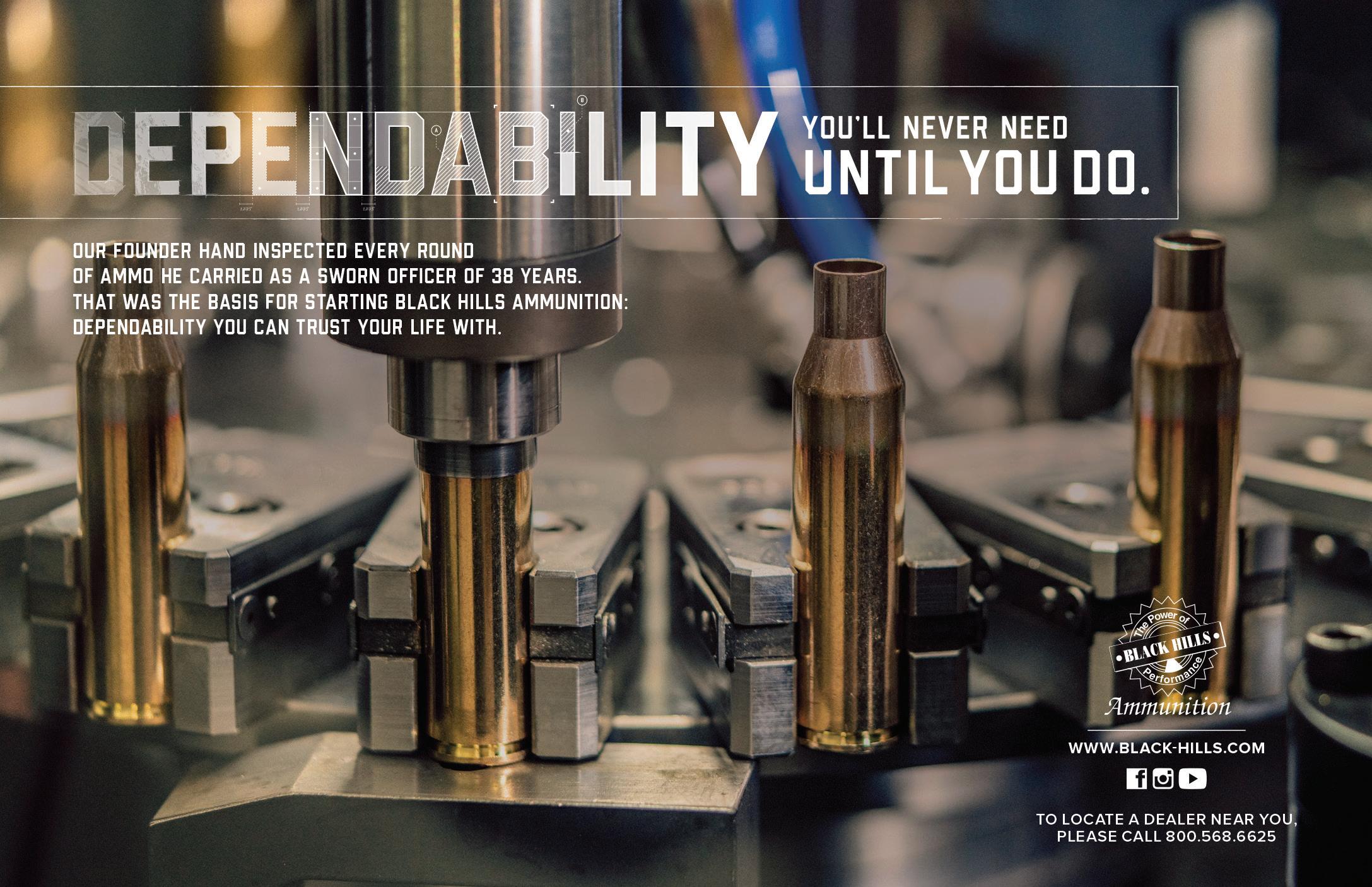
Haugen with a fall brown taken near the little village of Egegik. “When it comes to bear hunting in Alaska, the uncertainty of the hunt is what creates the excitement,” he writes. (SCOTT HAUGEN)

the cabin door, it was clear we’d had a visitor in the night. Fresh tracks in the sand revealed the brute had walked all the way around our thin-walled cabin, yet we hadn’t heard it.
“This bear will go 91/2 feet,” Bruce confirmed after studying the tracks.
We followed those tracks all day, glassing as we went. It had crossed over to the beach, then back into the rolling tundra, then to the beach again. Then it headed up a creek at low tide and into some dense willows.
Given all the open ground the bear spent time in, it was frustrating not to catch a glimpse of it. But then, minutes before dark, we spotted the bear. Again, it was too far to reach before darkness set in, but at least we had a starting point for the following morning.
That night a storm kicked up, which kept us captive inside the cabin. Given the sustained winds of 40 miles per hour with gusts up to 70, we knew we’d made the right choice. High winds in muddy tidal flats so close to the ocean are not a good mix, as navigating on foot and in a little raft can be dangerous.
The following day – with broken clouds passing overhead – was more promising. We didn’t even get out of the cabin before seeing a bear. Closer inspection through the spotting scope confirmed it wasn’t a giant bear, but one worth going after.
Using the tall marsh grass for cover, we snuck to the edge of a river. There we hopped into the two-man rubber raft we’d been pulling behind us with a rope and paddled our way across. Slogging through the thigh-deep mud was enough to test anyone’s patience and stamina. It was tough and slow going, but we made it.
When we popped up near where we’d last seen the bear, it was nowhere in sight.
We glassed and glassed. Twenty minutes later, Bruce caught a glimpse of brown.
No more than 150 yards away, the bear foraged through the tall grass. Given our position and the height of the thick grass, I had no shot. Raising the Bog Pod tripod a bit higher, I steadied the .375 H&H Magnum, hoping for a break.
The bear walked to a small rise, but all I could see through the scope was the top of its back. Then it stood on its hind
legs and looked right at us. Instantly, I hit it in the chest with a 300-grain Swift A-Frame bullet. The resounding thud was encouraging.
In short order, the bear reached racehorse speed and I wasted no time hitting it with another round. The shot hit the mark, but still the bear was on an allout sprint. I put the post of the Trijicon scope a foot past the bear’s nose and pulled the trigger a third time. That shot dropped the bruin with a hit in the neck.
When it comes to bear hunting in Alaska, the uncertainty of the hunt is what creates the excitement. Not knowing how bears will behave – either before or after the shot – keeps a hunter’s nerves on end. Laying eyes on the vast land stretching from horizon to horizon and taking in all its beauty is worth the price of admission alone. ASJ
Editor’s note: For signed copies of Scott Haugen’s best-selling books, visit scotthaugen.com. Follow Scott’s adventures on Instagram and Facebook.

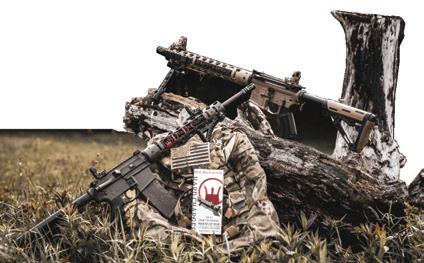
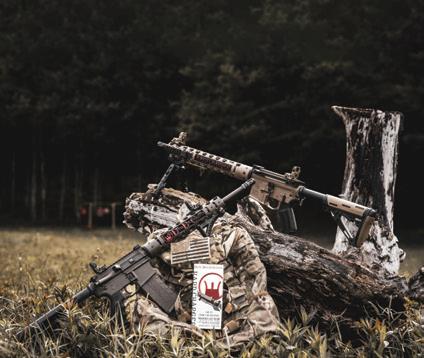
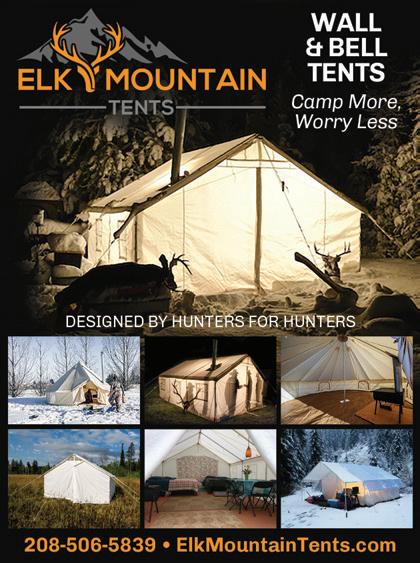



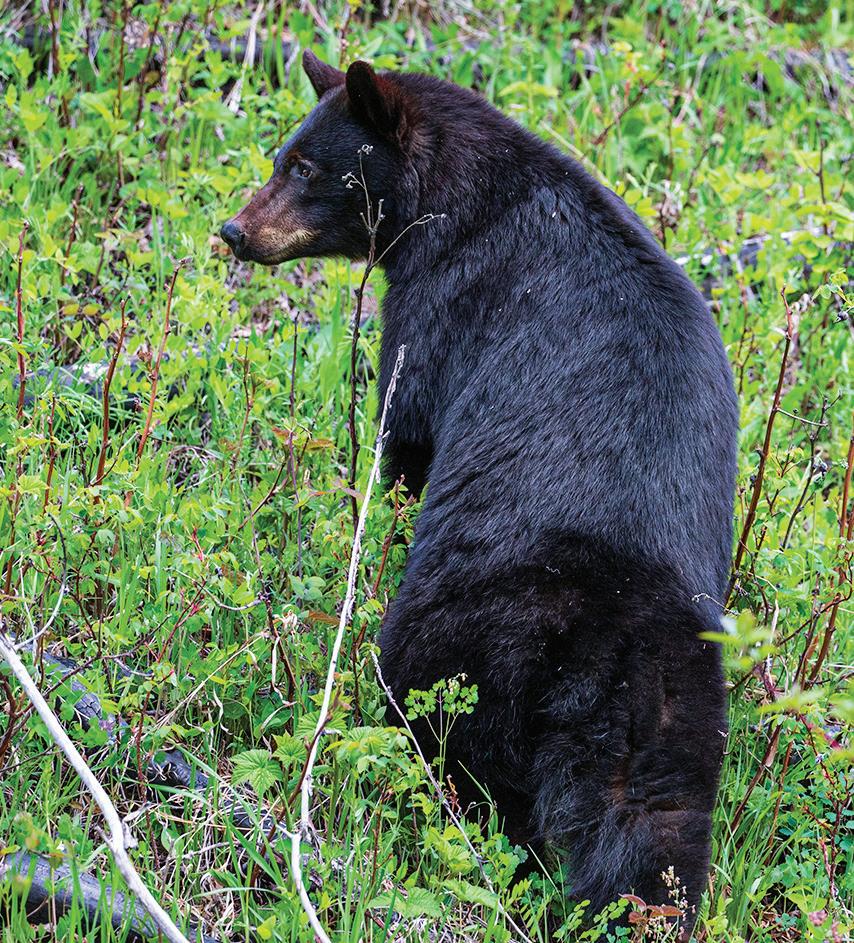
Spring bear season is here, and hunting them throughout Alaska can find you facing many challenges. From bugs to rain, snow to granite peaks, here are some pieces of gear I’ve tested and are items to seriously consider for your upcoming hunt.
SITKA CLOTHES
Having lived a semi-subsistence life in the Arctic in the 1990s and traveled much of the state for over 30 years, clothing is the most important item for hunters. I know there’s the rifle, scope, satellite phones and more, but the goal of every hunt is to return home safely. Other gear is vital to the success of the hunt, but clothing is essential for survival.
Most hunters in Alaska know of Sitka Gear. But what many folks don’t realize is that Sitka has developed complete clothing systems for hunters to meet everchanging conditions on a single hunt.
If bear hunting this spring, where
biting bugs thrive, Sitka’s Equinox hoodie and pants are great. They’re lightweight and breathable, yet mosquitos won’t penetrate the fabric.
Sitka’s Core Merino is amazing in terms of comfort and performance. This merino wool base layer is designed with a synthetic interior to move moisture on those cold mornings, meaning you can cover ground, sweat and stay comfortable. The lightweight, streamlined design is perfect for hunters on the go, as well as for sitting on stands.
For added warmth I like Sitka’s Jetstream jacket; it’s light, packable and efficient for hunting on the move. Their Thunderhead raingear combines a waterproof and breathable three-layer Gore-Tex fabric with a quiet, brushed polyester knit face to keep you dry and silent. The ergonomic fit is nice when moving through brushy terrain, raising binos and shouldering a gun. I first wore this rain gear on an elk hunt in the coastal

rainforest of the Pacific Northwest, where it poured all day. I stayed dry and have been relying on it ever since.
Hunting bears in the mountains of Alaska requires mobility and quality boots. Healthy feet are everything, and the new Ursa ES boots by LaCrosse are tops. ES stands for Early Season, and these are a great fit for spring bear hunting.
They feature a built-in Gore-Tex waterproof liner, exceptional gripping soles, are incredibly lightweight, breathable and offer top-notch support. They’re more like wearing athletic shoes than hunting boots, but with the added bonus of upper and ankle support. Little break-in time was required for me. I’ve logged over 35 hours in mine so far, and I love them.
Benchmade redesigned their popular Steep Country fixed-blade knife to make
Trout remains high atop the list of mild-tasting fish. Because of this, the flavor profiles you can add to trout are endless. Just think of some of your favorite cuisines around the world –or family favorite recipes – and decide if those tastes might work with fish.
Bacon is a popular add-on across many cultures and can jazz up any meal of the day. A little bit can go a long way to add smokiness, saltiness and crunch to an entree. The Japanese multipurpose seasoning furikake also adds savory pizazz to almost anything it’s put on. The perfect balance of seaweed, toasted sesame seeds and other Japanese seasonings, furikake is most often sprinkled over rice. When paired with bacon, chives and a little spicy mayo, your trout won’t know what hit it.
This recipe actually goes well with any fish species. It’s very tasty with pike and sheefish. We often take it camping and on road trips, as it’s simple and easy to add to any fish you want to cook. Furikake can be found in the Asian section of most grocery stores.
One large trout filet
1/2 fresh lemon
2 tablespoons mayonnaise
1 to 2 teaspoons Sriracha
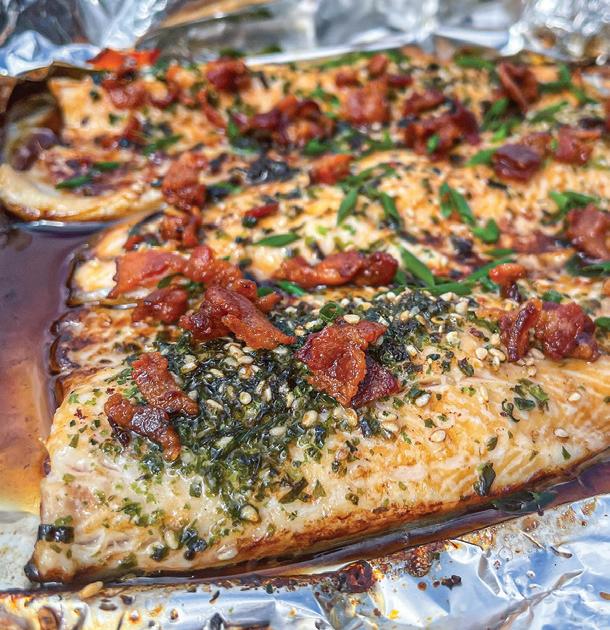
1/2 teaspoon white sugar
1 to 2 tablespoons furikake
Two to four slices cooked bacon
Two to three green onions or chives
Rinse trout and pat dry. Place skin-side down onto a baking sheet or aluminum

foil. Remove bones as desired. In a small bowl, mix mayonnaise, Sriracha and sugar until thoroughly combined. Chop bacon into bits. Squeeze fresh lemon juice over the fish. Spread spicy mayo mixture over the fish filets. Top with a generous sprinkling of furikake and bacon bits.
Bake in a preheated 375-degree oven or medium-high grill for 12 to 25 minutes or until fish reaches desired doneness or an internal temperature of 135 to 140 degrees.
Garnish with chopped green onions or chives.
Editor’s note: For signed copies of Tiffany’s popular book Cooking Seafood and other best-selling titles, visit scotthaugen.com.



it more precise and easier to handle and cut with, thanks to precise blade advancements. Lightweight and featuring a great grip when wet or covered in blood, this knife is a workhorse that keeps a great edge, even on tough hides.
Benchmade’s popular Meatcrafter knife now has a little cousin, the 4-inch Meatcrafter. This versatile knife is perfect for not only deboning a bear in the field, but also for skinning and caping. It’s a super camp knife and works well for butchering. My wife Tiffany loves this knife in the kitchen, where she uses it on big game and birds.
In the early 2000s, I helped test Thermacell’s Mosquito Repellent two years before it hit the hunting and fishing markets. I tested it throughout
Alaska in the most bug-infested places imaginable, and it worked.
It was a shock to everyone who witnessed it, especially when it performed wonders while king salmon fishing on the Nushagak. I still use them when hunting, fishing, camping, and even at home.
When bear hunting in the Interior with my 9-year-old boy one spring, we had a unit burning inside our ground blind. Even with the outside of the blind covered in tens of thousands of mosquitos, we didn’t get a single bite.
The unit runs on butane; the cartridge heats a small mat saturated with repellent that sits atop a metal grill. Heat vaporizes the repellent, sending it into the air.
And Thermacell’s newest MultiInsect Repellent not only keeps mosquitos at bay, but also keeps white socks and no-see-ums away. It works!
Place a thin, black reticle of a rifle scope on the dark hair of a black bear and it can be impossible to find the center of the crosshairs. The same is true for any animal in dark timber, heavy shadows or low-light situations. This is where Trijicon’s AccuPoint rifle scopes shine.
With an AccuPoint, just put the glowing dot on the precise point of impact. There’s no guesswork as to where the crosshairs are or where the bullet will hit. Tritium and fiber optics are the driving force behind the glowing dot within this scope.
On sunny days when shooting from a bright spot into shade, adjust the amount of sunlight allowed into the scope by simply turning the illumination dial. If shooting from a shaded position into sunlight, open the dial to optimize


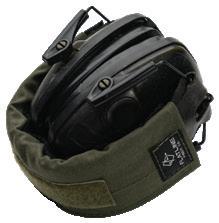

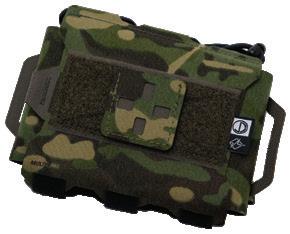


Not only is the Thermacell bug repellent unit great while on the hunt, but it’s also handy when breaking down big game in mosquitoinfested habitats (SCOTT HAUGEN)
light intake. This, combined with tritium will allow you to shoot amid the lowestlight situation imaginable.
I’ve hunted with Trijicon AccuPoints from 115-degree temperatures in Africa and Australia to more than 30-below zero in Alaska’s Arctic. I’ve used them in snow, ice, mud, saltwater, excessive heat and pouring rain in extremely high winds, and they’ve never let me down.
WHETHER YOU’RE LOOKING to gear up for spring bear or fall big game seasons, this is a gear list worth considering. I didn’t just pull words off company websites to provide the information. I tested these products for extended periods on multiple hunts in many situations, because in Alaska, compromising on gear can cost you more than an unpunched tag. ASJ
Editor’s note: Want to learn how to skin and break down a bear? Order Scott Haugen’s best-selling instructional DVD, Field Dressing, Skinning & Caping Big Game, at scotthaugen.com.


Known as the “Land of Living Skies” for producing some of the country’s most breathtaking sunsets, stormy horizons and northern lights, its sky is also home to one of the largest waterfowl populations on the continent.



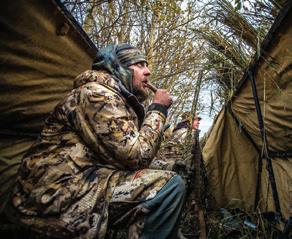

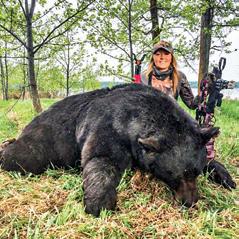
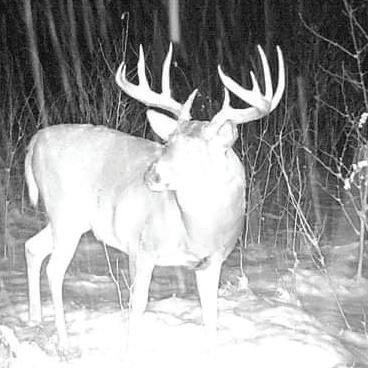
Hide Tan Formula has been used successfully by thousands of hunters and trappers across the U.S. and Canada. No more waiting several months for tanning. Now, you can tan your own hides and furs at home in less than a week, at a fraction of the normal cost. Our Hide Formula tans deer hides either hair-on for a rug or mount, or hair-off for buckskin leather. Tans all fur skins – muskrat, mink, beaver, fox, coyote, raccoon, squirrel, rabbit, etc. It also applies to bear, elk, moose, cowhide, sheep and even snakeskin. Hide Tan Formula is premixed and ready to use and produces a soft, supple Indian-style tan in five to seven days.
One 8-ounce bottle will tan one deer hide in two medium-sized fur skins. Bear, elk, moose and caribou require three to six bottles. Complete instructions are included. You’ll be amazed how easy it is!
Tanned hides and furs are great to decorate your home or camp and also to sell for extra income. Tanned hides and furs are in demand by black powder enthusiasts, American Indian traders, fly tyers, country trading posts and many crafters. Our products are proudly produced and bottled in the U.S. for over 20 years.
Available at Cumberland’s Northwest Trappers Supply in Owatonna, Minnesota.
Call (507) 451-7607 or email trapper@nwtrappers.com. nwtrappers.com



Over 50 Years Of Service To The Trap & Fur Industry
Cumberland’s Northwest Trappers Supply is your one-stop trapping supply headquarters, featuring one of the largest inventories in the U.S. We are factory direct distributors on all brands of traps and equipment which allows us to offer competitive prices. Give us a try. Our fast, friendly service will keep you coming back. Request A Catalog Or Place An Order

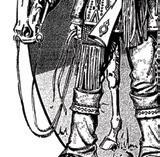



If you get in


